In watchmaking, aventurine has swung in and out of fashion over the years. However, even though its use does seem a bit cyclic, I’ve never noticed it being used in anything but extremely rare occasions. So while many recognize the name “aventurine” and its distinctive look, it is not a widely known material in horology.
Despite seeing aventurine in six new wristwatches at SIHH – more than the number of new tourbillons I counted! – it remains a decorative artisanal element used only by luxury watchmakers in small series or unique pieces for its beauty and decorative properties.
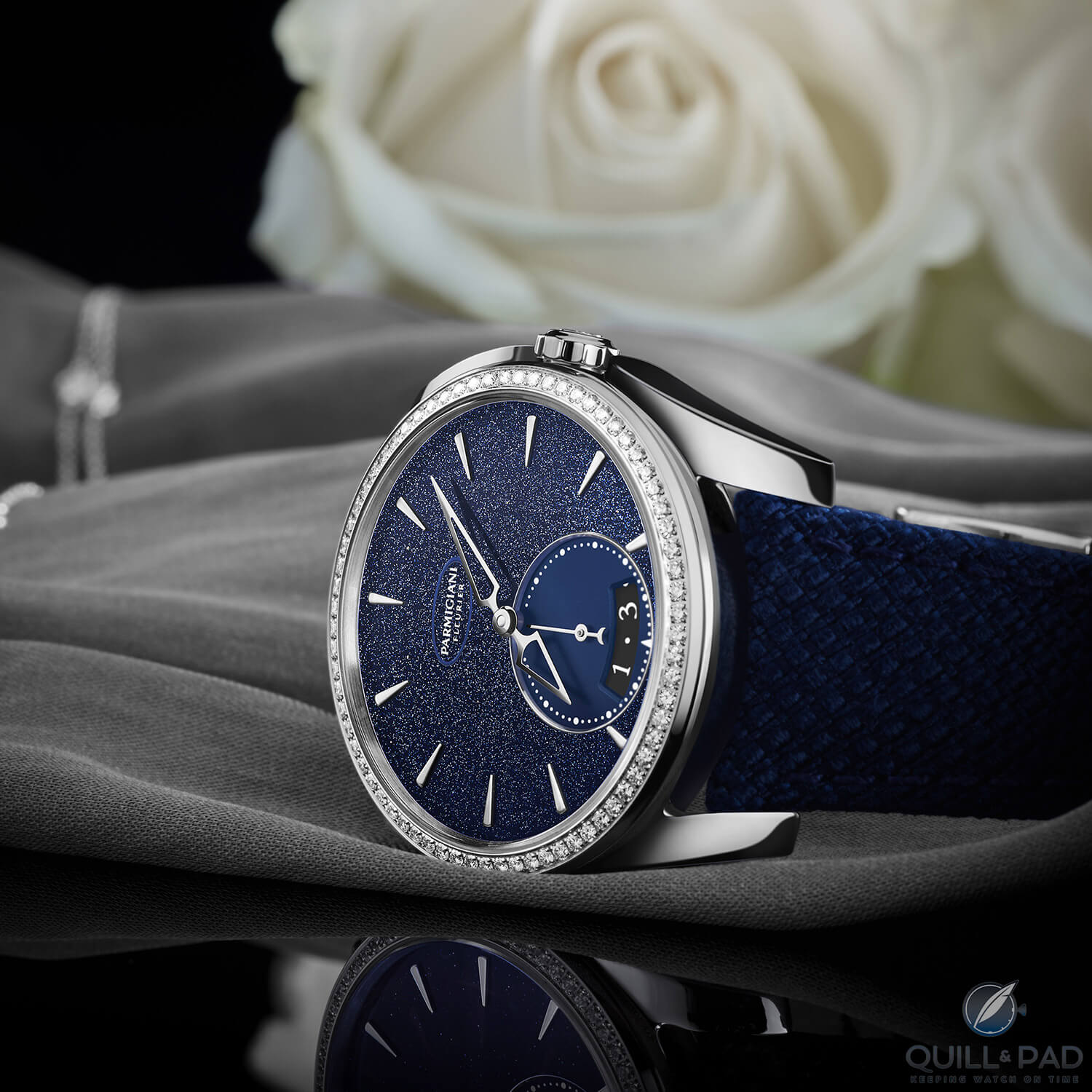
The Parmigiani Fleurier Tonda Métropolitaine Galaxy: one of six new watches with aventurine dials at SIHH 2018
Nonetheless, there remains some unclarity about what aventurine actually is, with watch brand representatives even claiming it to be a stone at times. Here is the truth about what aventurine really is and where it comes from.
Aventurine: scintillating glass
Aventurine was “discovered” by chance by Italian glassblowers in Venice in the seventeenth century, who discovered it “by chance,” which is the root of the name avventurina it was given.
The original manufacturing license for it was granted at this time to the Miotti family by the chief magistrate (doge) of Venice. Though there is no documentation to support it, urban legends dictate that the material also existed up to 500 years earlier (and Wikipedia cites the existence of an amulet from twelfth-century Persia).
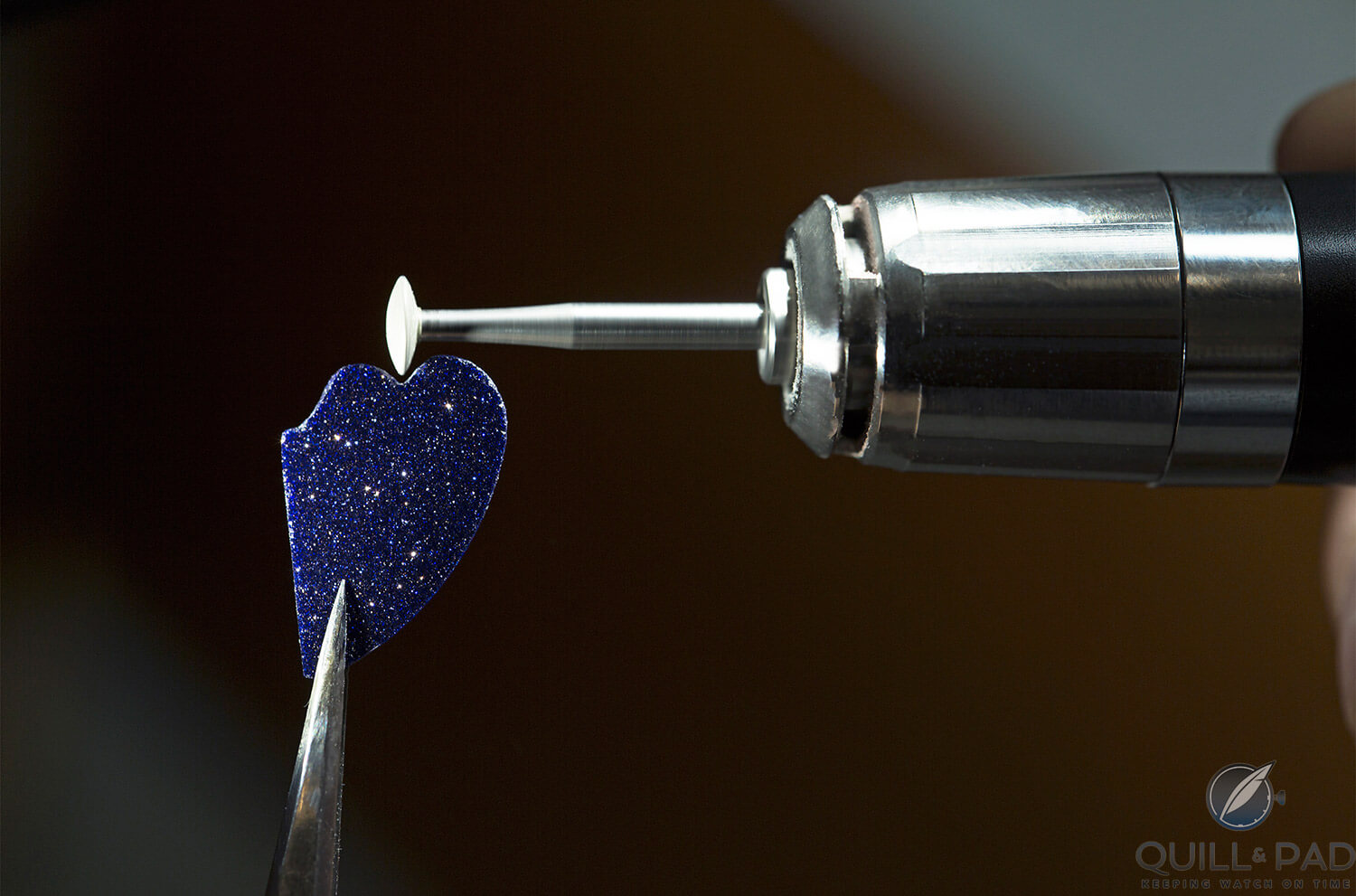
Carefully sculpting an aventurine cloud for the Van Cleef & Arpels Nuit Féérique introduced at SIHH 2018 (photo courtesy Johann Sauty)
A short history called Murano, its Glass, and its People edited by Stanley B. Kruger cites the earliest documentation of aventurine glass as 1626.
However, journalist Yannick Nardin has dug out other possible origins as she writes in the HH Journal: she found out that according to The Oxford Companion to the Decorative Arts, the ancient Egyptians had already mastered making this type of glass. There it was also described that the recipe had been lost and revived over the centuries.
Other sources, according to Nardin, also claim that the original “by chance” story was invented so as to keep the recipe a secret.
The true origins of aventurine are apparently as murky as the glass’s color can be.
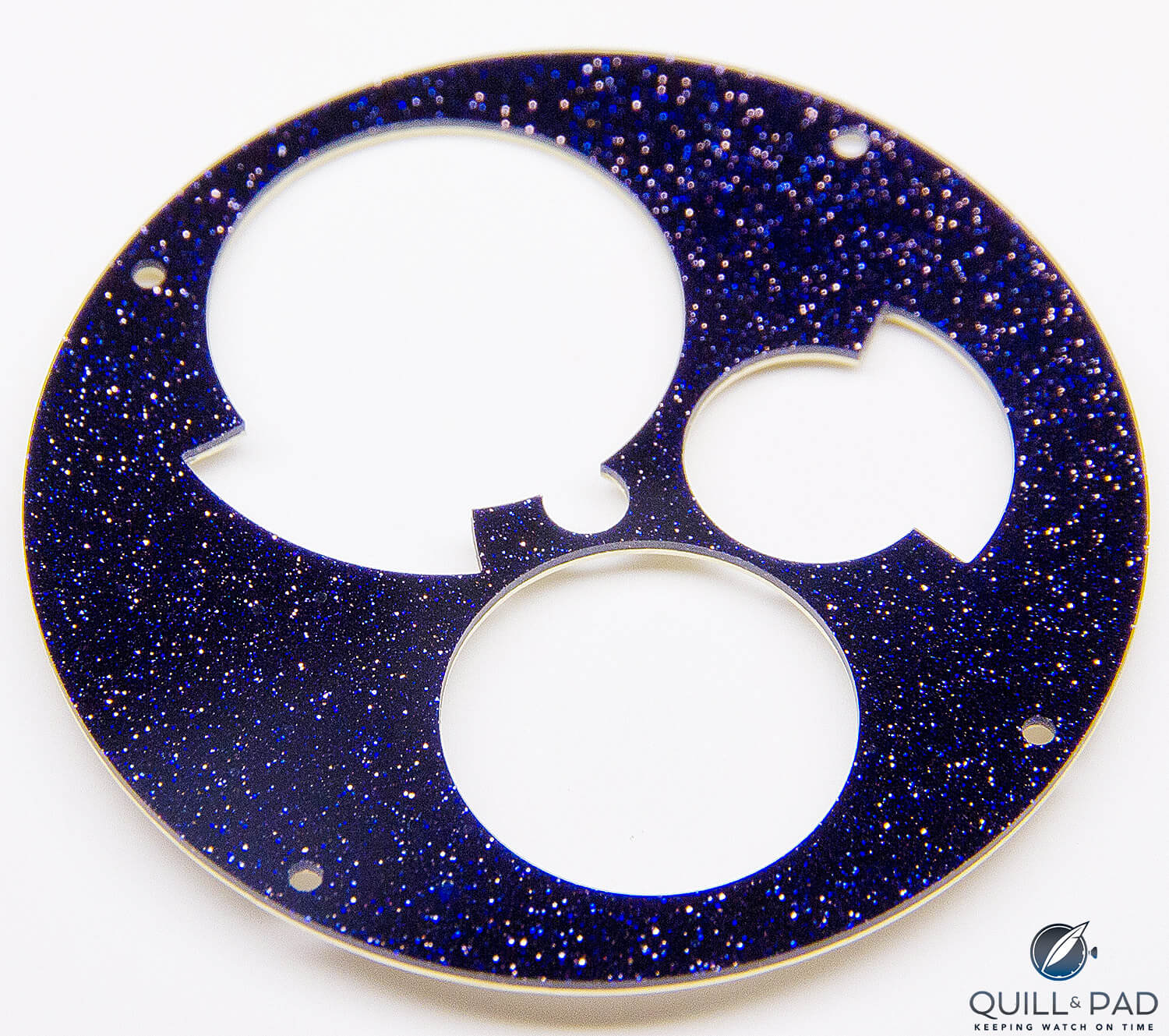
An aventurine dial from the Louis Moinet AstroMoon
Aventurine glass is made using transparent red copper ruby glass and a purpurin glass, which is brown to deep red in color. When cobalt is substituted for copper, the glass turns blue, creating the type of aventurine primarily used in wristwatches.
The blue glass – which can also be green or most commonly golden brown, though I have never seen these used in watches – contain flecks of copper that shimmer like stars in a midnight sky.
While it is beautiful, it can also be tricky to work with. Watch designer Georg Bartkowiak calls working with aventurine – a material he loves – a “surprise package,” citing inherent “inclusions” (especially of the green glass material) and its fragile nature as not always making it uniform. “And the bigger the piece, the more fragile it becomes. For a dial it should be thick to remain reliable,” he explains.
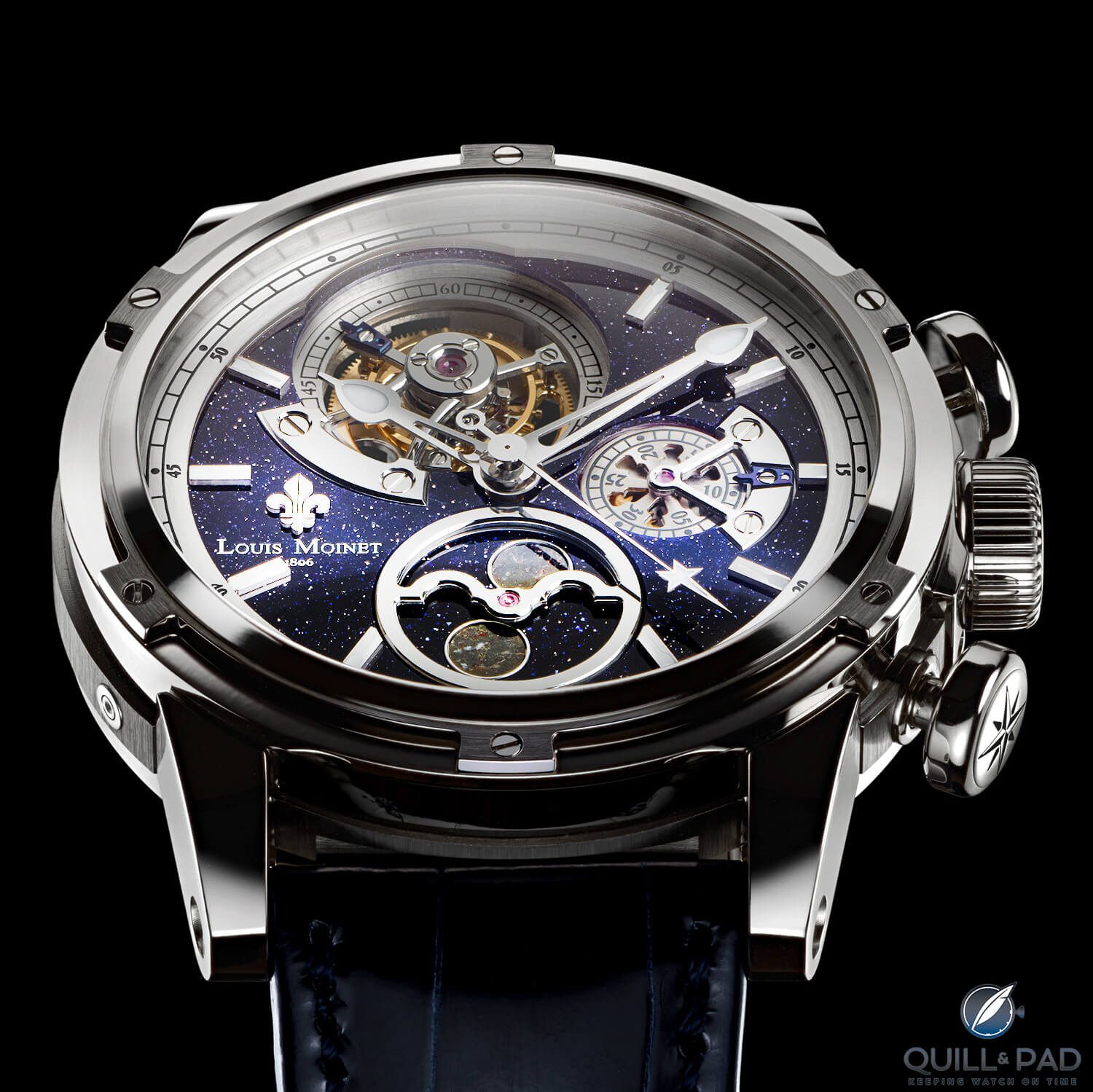
AstroMoon by Louis Moinet with a beautiful and complicated aventurine dial
Jean-Marie Schaller, CEO and creative director of Louis Moinet, loves to work with aventurine glass on his otherworldly creations. “We work exclusively with Daniel Haas, who is a master in this field,” he explained to me recently of his prized supplier.
“For instance, when making our AstroMoon Tourbillon with aventurine dial, Daniel had to craft five dials to obtain one successful final dial. The high percentage of defective dials is due to the nature of the material: glass breaks easily, especially when cut at 0.5 mm. All this requires a lot of precaution to manipulate this highly fragile material. It is also challenging after the silk-screen operation, when the dial is put in the oven at a temperature of 80°C. The glass can break here also due to dilatation.”
Quick Facts Louis Moinet AstroMoon
Case: 46.5 x 16.15 mm, white gold
Movement: manually wound Caliber LM29 (based on historic caliber) with one-minute tourbillon and column wheel chronograph, 3 Hz/21,600 vph frequency, 46-hour power reserve
Dial: aventurine
Functions: hours, minutes, seconds; chronograph, moon phase
Limitation: 12 pieces
Price: $255,320
Is aventurine set to become rare?
In her article, Nardin mentioned that production in Murano is “virtually at an end” due to harmful substances used in its manufacture that have now been banned.
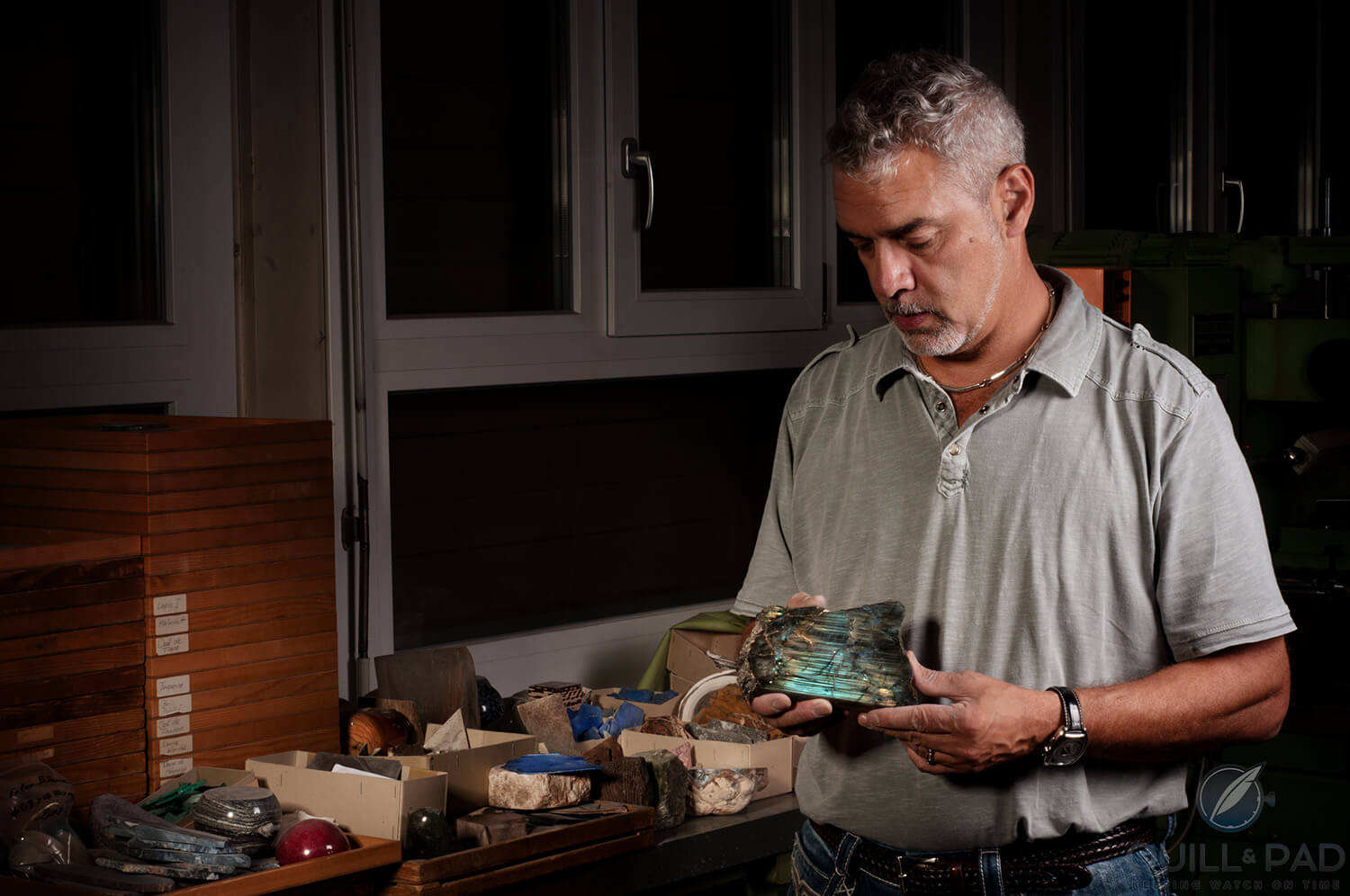
Daniel Haas (photo courtesy Louis Moinet)
Daniel Haas, owner of one of the primary Swiss suppliers of rare semiprecious gemstones and other materials for watch dials, agrees that this could become a problem in the long term, “especially for larger series [that use the glass for dials]. However, since we use our material only for our own clients and luckily still have enough stockpiled, we won’t run out any time soon.”
Haas did mention that he has already seen nice material from China that could be used instead of the Murano supply, but naturally clients of the caliber he serves prefer to use material that carries the mystique and traditional connotations of the Venetian island.
And Nardin told me that she learned that the material is also stockpiled in Murano, so I’m guessing we’ll continue to see watches with aventurine dials for quite a while yet.
“Daniel still has a stock of aventurine that dates from the 1970s when it was not yet so well known,” Schaller confirmed. “He has four different colors: blue (the best known color in watches); black (which is less luminous as it has less filings than the blue); green (very rare, looks like a glass bottle); and brown/gold.”
Aventurine feldspar: a natural mineral
A geological feldspar by the name of aventurine also exists. It was named after the glass and more commonly goes by the name sunstone. Orange or reddish brown in color, it glitters with sunny beauty.
According to the 1911 Encyclopaedia Britannica: “The mineral aventurine takes its name from the well-known aventurine glass of Venice. This is a reddish brown glass with gold-like spangles, more brilliant than most of the natural stone. The story runs that this kind of glass was originally made accidentally at Murano by a workman, who let some copper filings fall into the molten ‘metal,’ whence the product was called avventurina. From the Murano glass the name passed to the mineral, which displayed a rather similar appearance.”
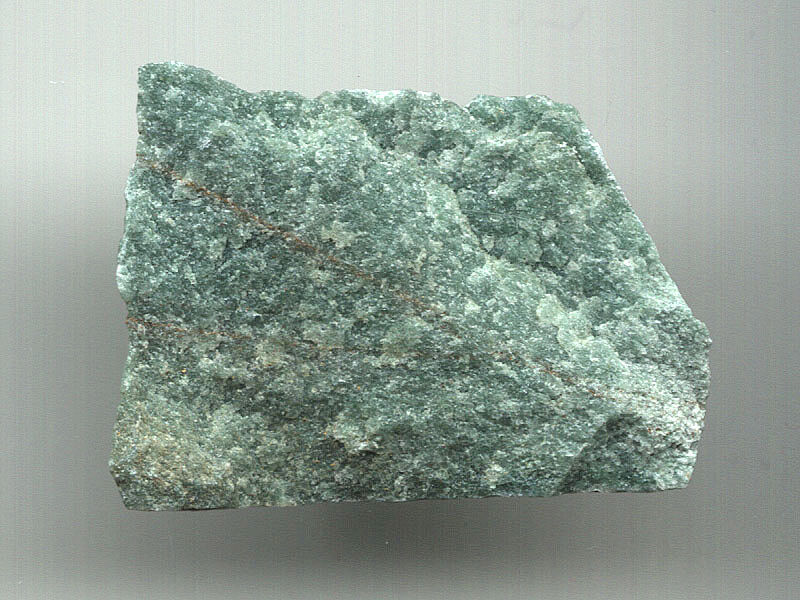
Mineral aventurine as it occurs in nature (photo courtesy Doobuzz/Wikipedia)
There is also a mineral called aventurine that belongs to the quartz family. More often than not it is green in color with metallic particles of fuchsite; it is most often used as cabochon-cut jewelry and is on occasion mistaken for jadeite. Measuring seven on the Mohs scale, it was named for its similarity to the sparkling glass called aventurine.
While in the watch industry, the glass is far better known than the mineral stones, it is the natural stones – which are often used in healing, chakra, and jewelry – that most people are familiar with.
Aventurine is called Goldfluß in German, which translates to “goldstone” in English. It is my firm belief that some confusion comes from the translation (as so often happens in the watch industry with various technical terms and jargon). Though this is not necessarily a mistranslation – Goldfluß literally translates to “gold river” – the word “stone” seems to have caused some puzzlement at times.
However, “goldstone” is where Wikipedia lists the glass that the watch industry commonly calls aventurine. So go figure.
Aventurine in watches
It is not a commonplace element, but a number of watch brands have used aventurine in special and/or limited edition models over the years. Brands particularly love to combine it with white diamonds to show off the intense sparkle of both elements.
The glass, which is not particularly easy to handle in the manufacturing and assembly stages, goes well with celestial themes, cosmic in nature, where it resembles a sky full of stars.
Daniel Haas remembers the first watch his firm made an aventurine dial for. “It was in the 1970s, a Rado Diastar!”
Later, he recalled, his family-run company continued with aventurine dials for brands like Ulysse Nardin, Jaeger-LeCoultre, Bulgari, Audemars Piguet, and of course Jaquet Droz, with whom he has made a meaningful number of rare stone dials over the course of many years.
Oddly, Omega
It was also Haas who put the aventurine dial on the 1970s Omega Constellation Megaquartz Stardust – which also happens to be the earliest watch with an aventurine dial I have personally seen.
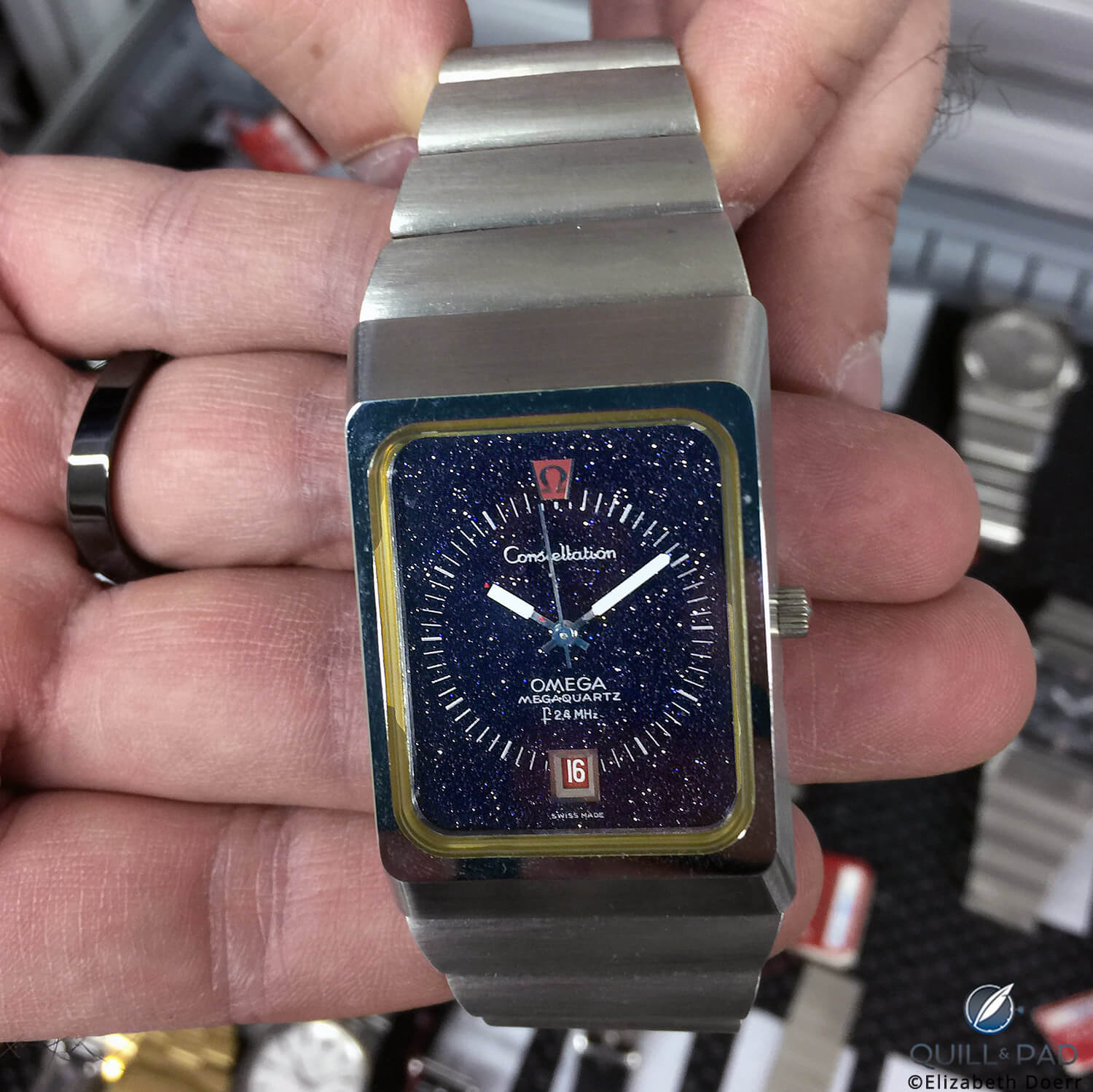
Omega Constellation Megaquartz Stardust in the Omega Museum archives
The Megaquartz was the next extension of the famous Beta 21 – the first quartz watch at Omega, whose sci-fi-like accuracy resulted from a consortium of brands researching quartz. “The middle to the end of the 1970s is where the Megaquartz models came in,” Omega museum director Petros Protopapas told me in November 2017 as he showed me a drawer full of Megaquartz specialties. When I picked up the Stardust model to look at closer he said, “I would say this is a ‘beauty version’ with its special aventurine dial.”
Quick Facts Omega Constellation Megaquartz Stardust
Case: 32.5 x 49 mm, available in 18-karat gold or stainless steel
Movement: electroquartz Caliber 1510, 2.4 MHz frequency, 13 jewels
Dial: aventurine
Functions: hours, minutes, seconds
Most recent auction price: 5,625 Swiss francs at Christie’s in 2015
In a 2015 auction catalog, Christie’s incorrectly describes the aventurine dial of this Omega model as a stone, stating, “Aventurine is an ornamental stone constituted of quartz (blue, grey, green, orange, yellow or gold-brown) with inclusions of mica or hematite, giving the shimmering or glistening effect also called ‘stardust’.”
This is a prime example of how easy it has been to add to the confusion surrounding the origins of aventurine.
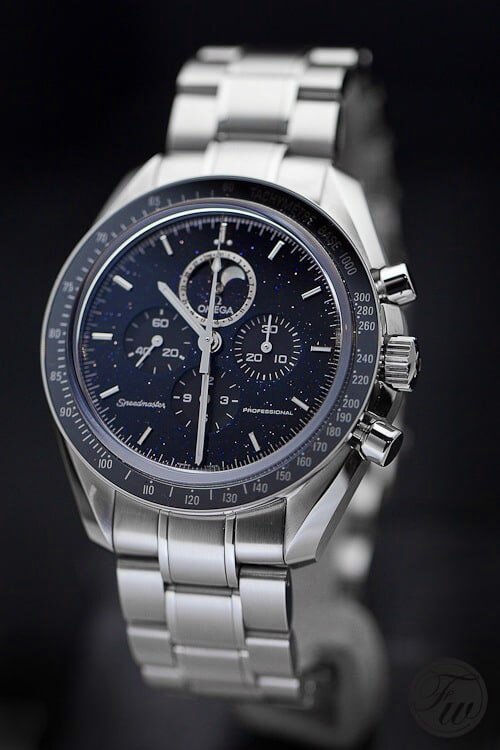
Omega Speedmaster Professional Moonphase Aventurine (photo courtesy Fratello Watches)
One of the most intriguing uses of aventurine at Omega is for me 2012’s Speedmaster Moonwatch Professional Aventurine because I find this particular juxtaposition to be . . . well, weird.
I get what Omega was trying to do: put a “night sky” in place as a dial to emphasize the “moon watch.” But the mélange of sports chronograph and elegant aventurine glass doesn’t work well for me. And, truth be told, the stainless steel case doesn’t set it off the same way white gold and/or diamonds would have.
In fact, I don’t think this model ever became popular. One of the very few references to it I’ve found online is a short article by Fratello Watches’ Robert-Jan Broer, who explained that many have thought this to be a phantom model. Broer also perpetuates the idea in the article that this dial is made of stone, which I can only assume he got from the original press release. Haas has confirmed to me that it is indeed the glass material.
Quick Facts Omega Speedmaster Professional Moonphase Aventurine Reference 311.30.44.32.01.001
Case: 44.25 mm, stainless steel
Movement: manually wound Caliber 1866 (base Lémania Caliber 1884)
Dial: darkened aventurine, moon phase subdial at 12 o’clock: moon comes out from behind aventurine disk
Functions: hours, minutes, seconds; date, chronograph, moon phase
Price in 2012: $11,500/€8,600
Use of real aventurine stone: as rare as hen’s teeth
I became very intrigued by the idea of a brand using the real stone as a watch dial and wondered if anyone had done it before.
My own research came up empty, at which point I asked our Martin Green, who holds a GIA certificate, if he’d ever seen one. After some research, he pointed out two instances to me.
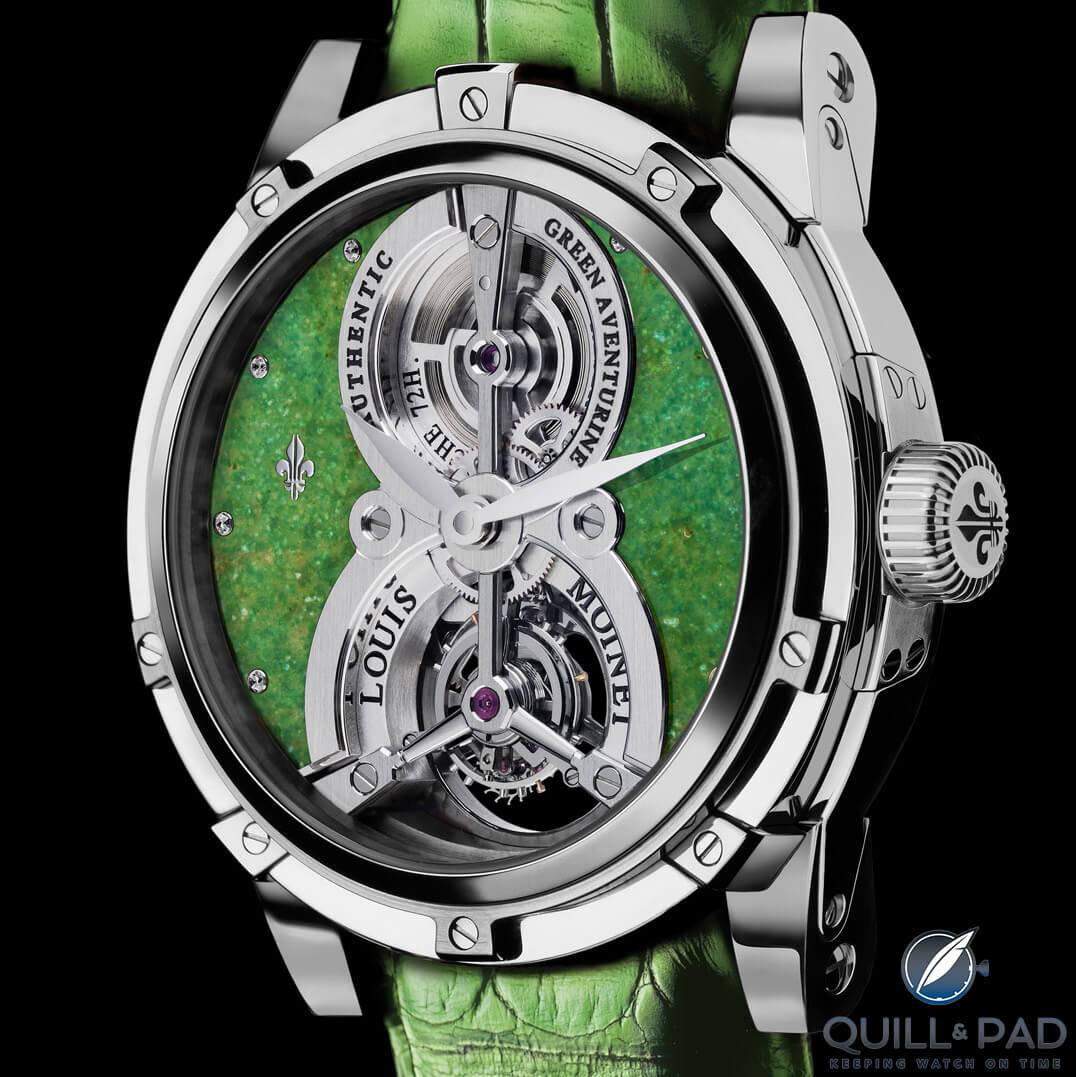
Louis Moinet’s Treasures of the World Green Aventurine Vertalis Tourbillon seems to be only one of two wristwatches fitted with a mineral aventurine stone
One he found was a vintage Rolex, which I was not able to find more information on. But the other instance is Louis Moinet’s unique piece Treasures of the World Green Aventurine Vertalis Tourbillon, which constitutes the only occasion that this independent boutique brand has used a natural aventurine stone.
“The purpose of our Treasures of the World collection is to enable collectors to discover some natural stones that are not well known. Green aventurine is part of the mythical, beautiful, and mysterious stones that are little known by the public,” Louis Moinet’s Schaller explained during our aventurine conversation.
He also told me that it is completely different from working with glass aventurine – which this boutique brand does quite often to emphasize its watches’ otherworldly themes and connection to space. “It is as difficult to work with as other stones; only meticulous work enables us to cut and polish it to precision.”
Schaller was enamored of the beauty and strong color of the green aventurine stone, which Daniel Haas sourced and worked for use in this watch.
Quick Facts Louis Moinet Treasures of the World Green Aventurine Vertalis Tourbillon
Case: 47 mm, white gold
Movement: manually wound movement with one-minute tourbillon, 3 Hz/21,600 vph frequency, 72-hour power reserve
Dial: natural green aventurine stone
Functions: hours, minutes
Limitation: one unique piece
Jaquet Droz: a pioneer in the modern use of aventurine
Jaquet Droz has worked with Daniel Haas for decades on watches with unique and unusual stones. Haas is also behind the Swatch Group brand’s watches outfitted with aventurine dials – and there have been quite a few.
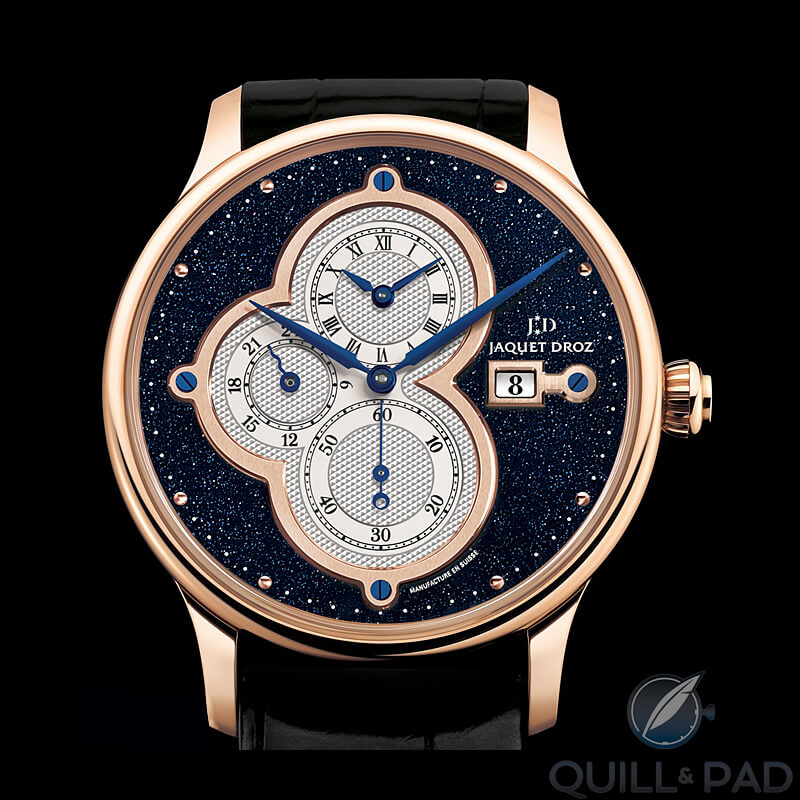
Jaquet Droz’s complicated Les Deux Fuseaux model from 2009 with aventurine dial
Les Deux Fuseaux from 2009 is a good example of a complicated watch with an almost equally complicated dial. The aventurine used as the background has screws and cutouts requiring extra care in adding the glass material, which could easily break during drilling, cutting, screwing, and polishing steps.
Keep in mind that the aventurine is first cut into slices that are 1.5 mm thick before it gets polished to become 0.8 mm and thinner to be added to a watch.
Quick Facts Jaquet Droz Les Deux Fuseaux
Case: 43 x 11.85 mm, white gold
Movement: automatic Caliber 5L60 with twin spring barrels, 100-hour power reserve, free-sprung balance
Dial: aventurine
Functions: hours, minutes, seconds; date, second time zone, 24-hour display
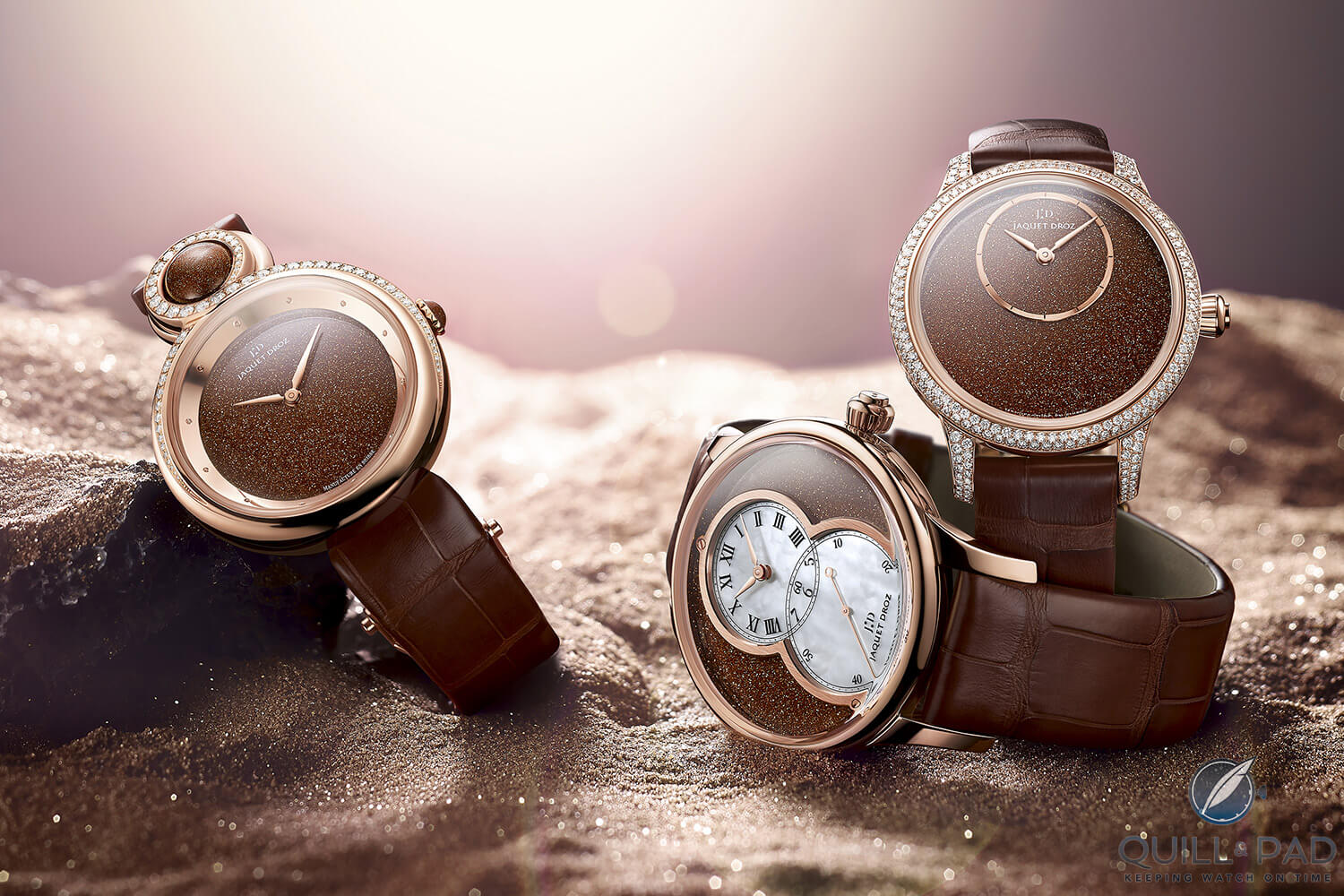
Trio of Jaquet Droz Sunstone watches from 2015: (L to R) Lady 8, Grande Seconde Cerclée, Petite Heure Minute 35 mm
The most unusual of Jaquet Droz’s use of the material is however certainly the trio of Sunstone watches introduced at Baselworld 2015.
The Petite Heure Minute 35 mm gets a whole new look with the red aventurine dial, and the use of this particular model is genius in highlighting the infinite sparkles of the glass material with little else to distract.
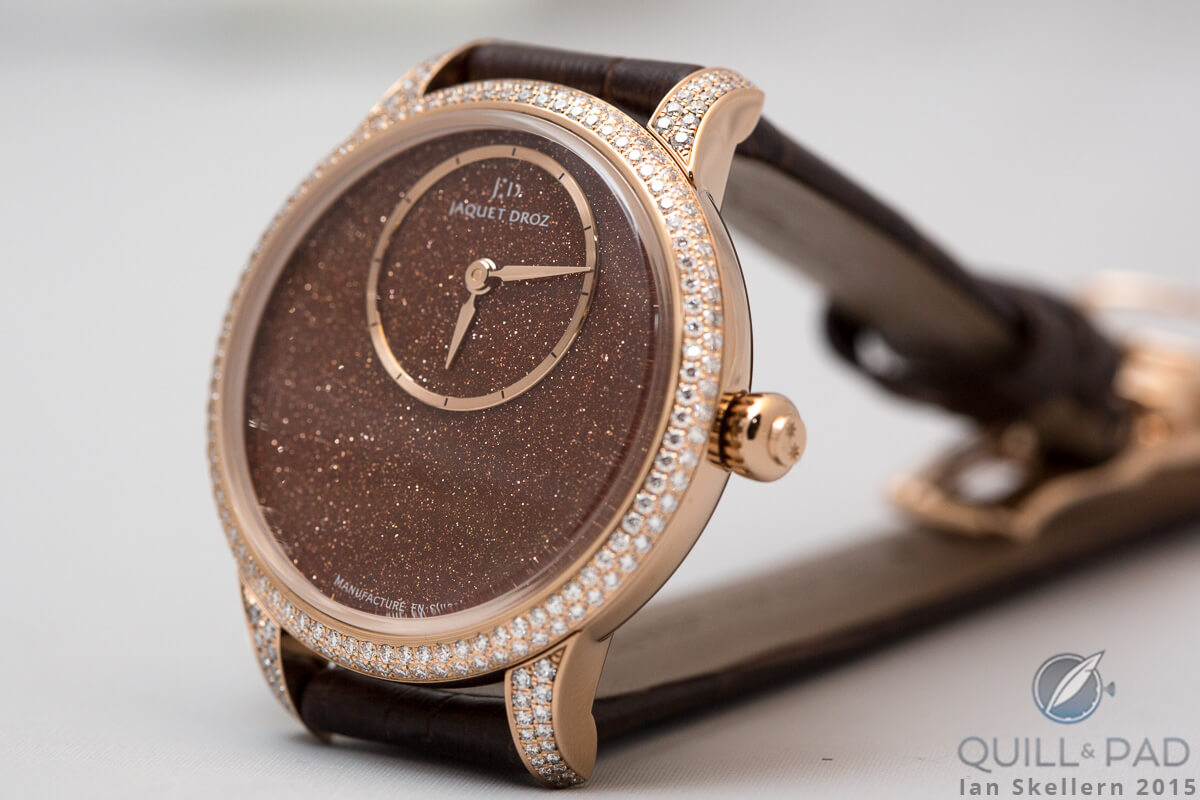
Jaquet Droz Petite Heure Minute 35 mm with ‘sunstone’ (aventurine glass) dial
As this was a trio of Sunstone watches, there are two other equally beautiful examples: the Grande Seconde Cerclée, whose “infinite eight” formed by two interlocked dials is very carefully set upon the background of red aventurine, and a Lady 8, which becomes even more sensual, turning it into an exquisitely feminine jewelry watch.
Quick Facts Jaquet Droz Petite Heure Minute 35 mm Sunstone
Case: 35 x 10.4 mm, red gold set with 232 diamonds (1.22 ct)
Movement: automatic Caliber 2653.P with silicon balance spring and pallet fork, twin spring barrels, 68-hour power reserve
Dial: red aventurine
Functions: hours, minutes
Limitation: 88 pieces
Jaeger-LeCoultre and aventurine
Unusually, Jaeger-LeCoultre brought out red aventurine in its Rendez-Vous Celestial that same year – hot on the heels of the Rendez-Vous Celestial with blue lapis lazuli that had come out in 2012 (see Serious Horology For Women: The Jaeger-LeCoultre Rendez-Vous Celestial).
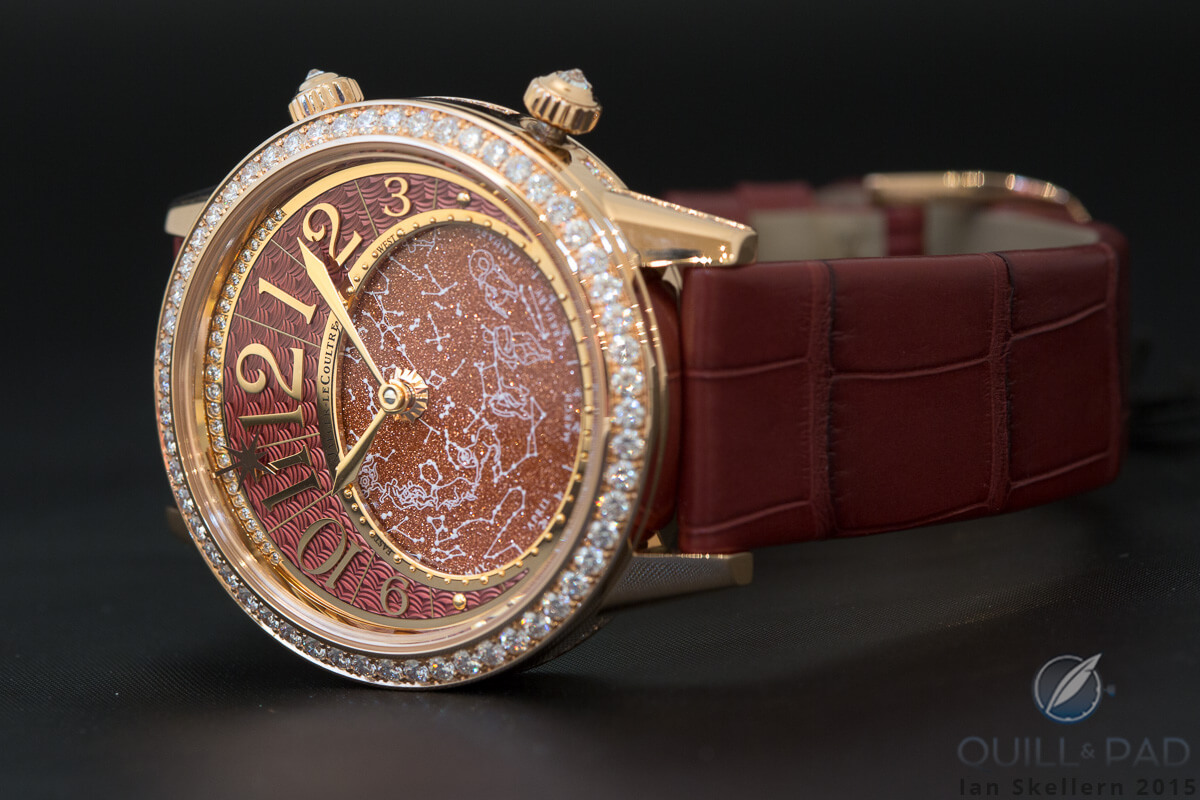
Scintillating Rendez-Vous Celestial with red aventurine by Jaeger-LeCoultre
This watch in both iterations is one of my all-time favorites with its focus on both high mechanics and feminine sparkle in a more-than-wearable case for any wrist size.
Quick Facts Jaeger-LeCoultre Rendez-Vous Celestial Bordeaux
Case: 37.5 mm, 18-karat pink gold with 139 brilliant-cut diamonds (1.94 ct)Movement: automatic Caliber 809/1, 40-hour power reserve
Dial: red aventurine underneath sky chart with hand-guilloche metal coated with red lacquer
Functions: hours, minutes; rotating sky chart with zodiac constellation indication (driven by an annual calendar); “rendez-vous” hand
Price: $51,000
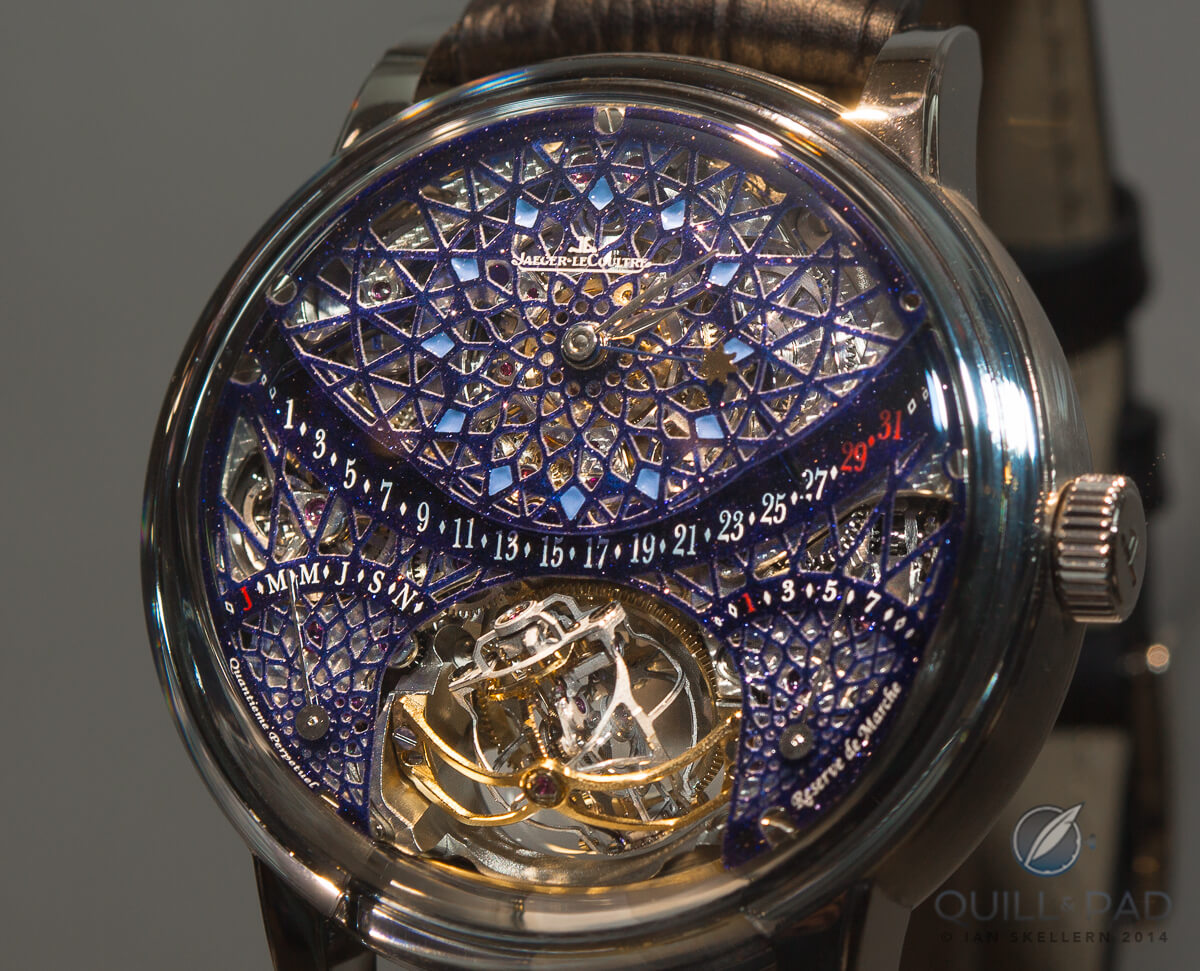
Jaeger-LeCoultre Hybris Artistica Master Gyrotourbillon
Jaeger-LeCoultre has also harnessed the magic of blue aventurine in other watches, but the one that really stands out as a masterpiece is 2014’s Hybris Artistica Master Gyrotourbillon, which features a skeletonized dial made of the material. I would not want to have been the artist working on that one! See more about the 12 incredible Hybris Artistica pieces in When Art Ticks: Why Jaeger-LeCoultre Is A Master Of Art And Mechanics.
Astronomically themed: Christiaan van der Klaauw and Van Cleef & Arpels
Christiaan van der Klaauw has been peppering its astronomical timepieces with aventurine since Daniël and Maria Reintjes took over from the independent Dutch watchmaker who was ready to retire. Daniël Reintjes likes to concentrate on the astronomical themes of the watches, which you can read more about in Visiting Christiaan van der Klaauw: To The Moon And Back!
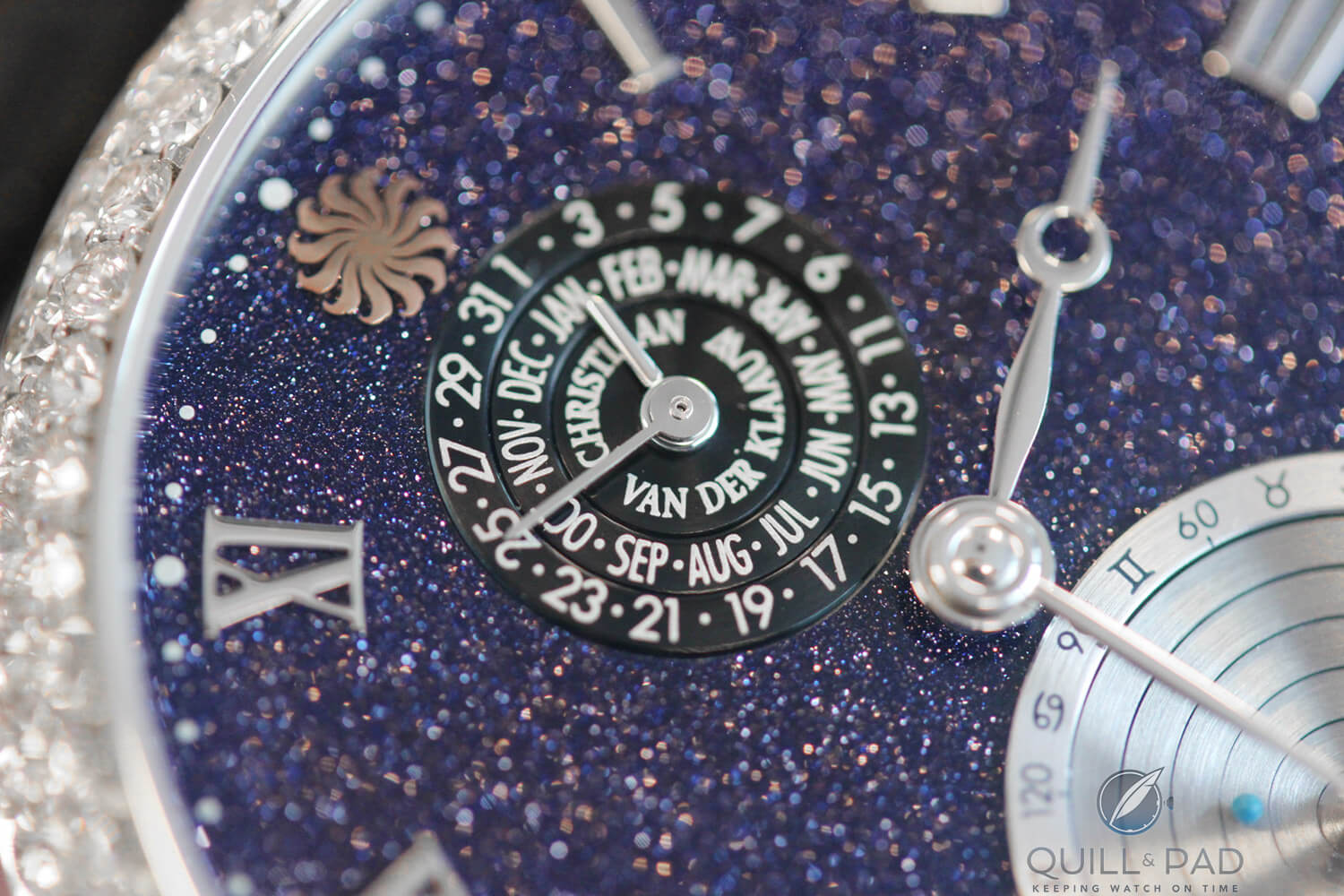
Dial detail from Christiaan van der Klaauw’s Planetarium: the aventurine dial sparkles in conjunction with the technical elements and the ring of diamonds around the bezel (photo courtesy Boris Pjanic)
Using aventurine to make a starry sky background fits perfectly with these astronomical themes – which is just one thing Christiaan van der Klaauw shares with Van Cleef & Arpels, though not the only thing.
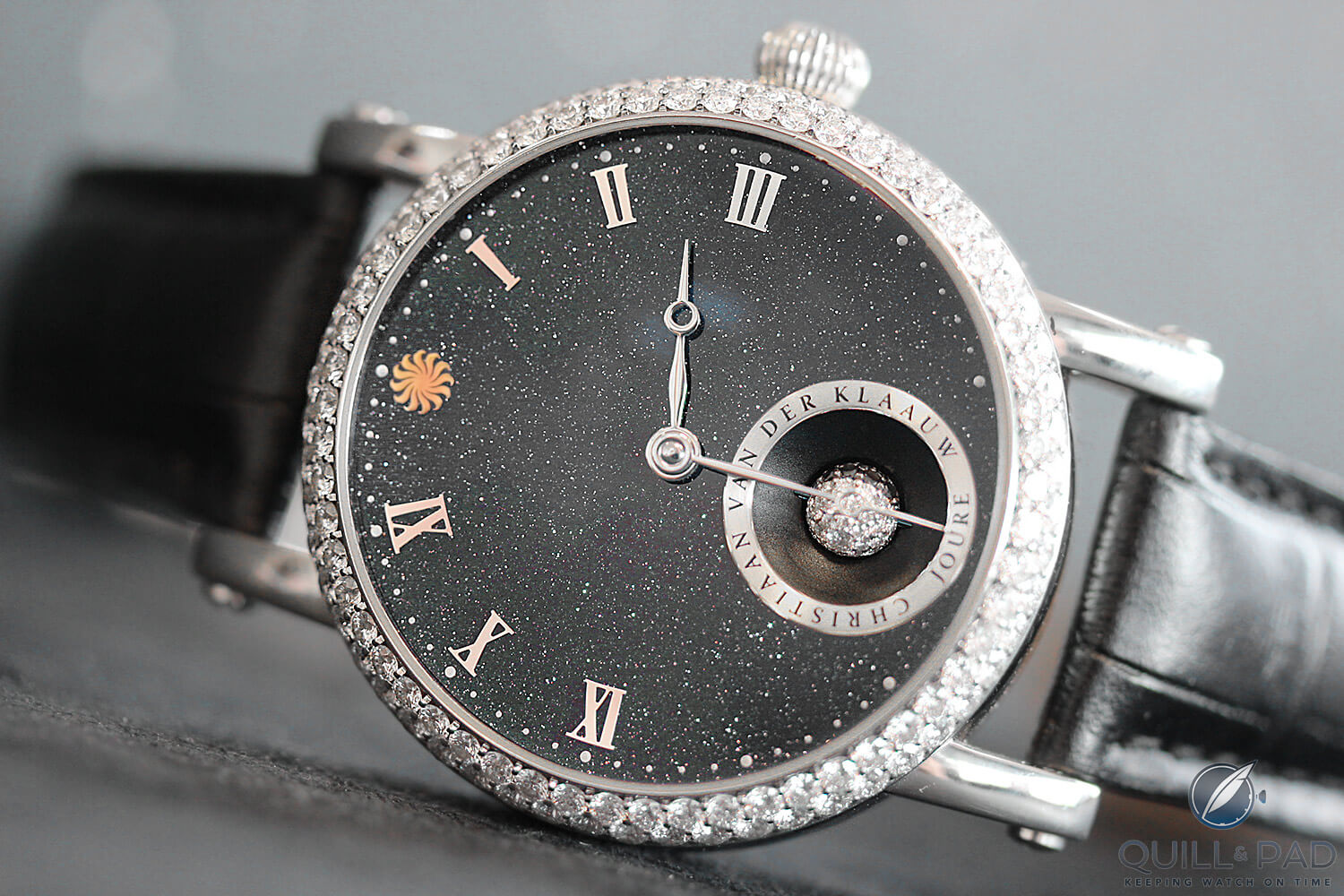
The Christiaan van der Klaauw Real Moon Joure with aventurine dial combines both the aventurine and the diamonds in an extraordinary way (photo courtesy Boris Pjanic)
In 2014, the boutique brand collaborated with the French/Swiss jewelry icon to create the Midnight Planetarium Poetic Complication, Van Cleef & Arpels’s most complicated and expensive timepiece to date (learn more about it in Astronomical Design: Talking To Daniel Reintjes, CEO Of Christiaan Van Der Klaauw).
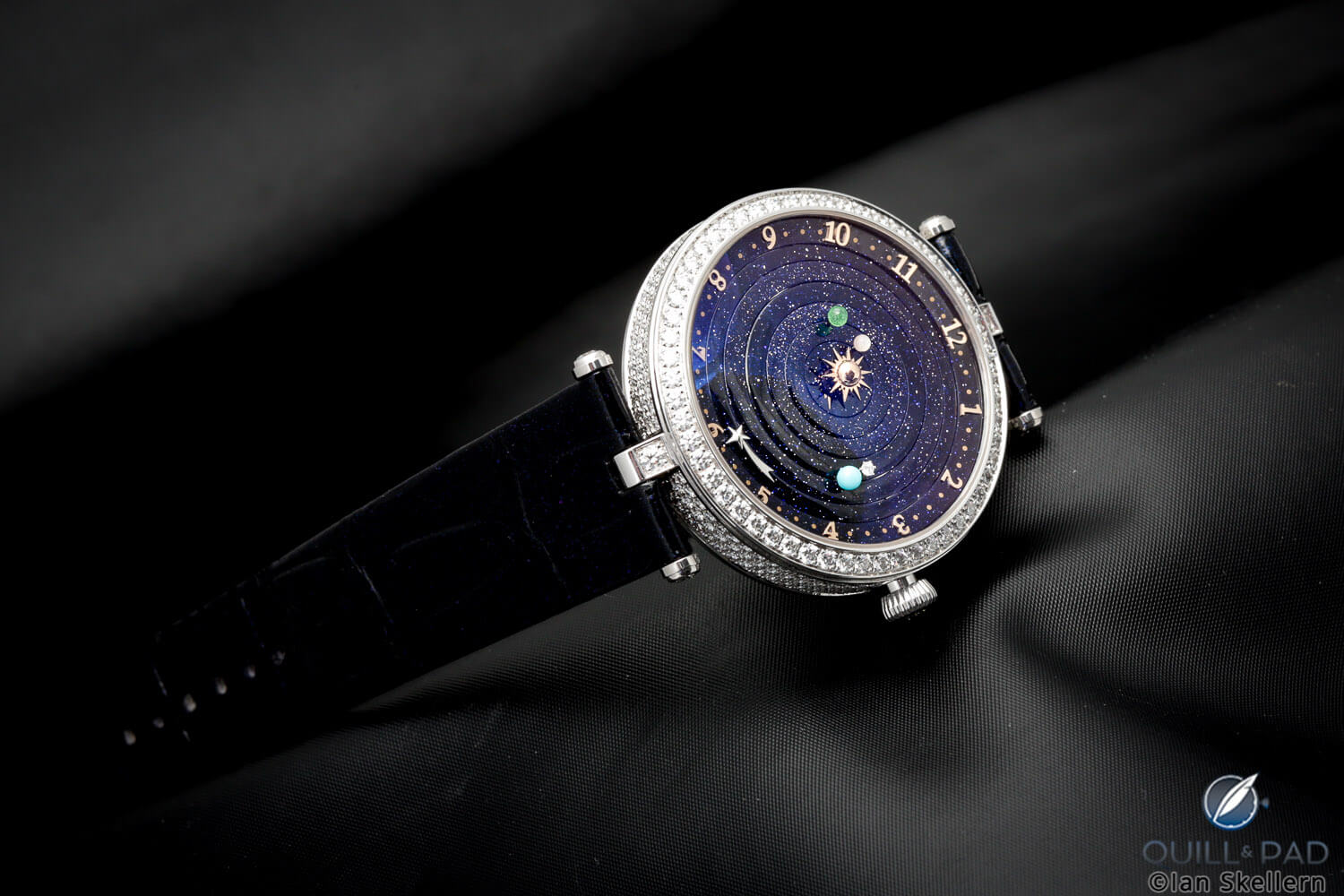
Van Cleef & Arpels Lady Planétarium
And for the 2018 edition of SIHH, the two companies collaborated again to release a very wearable 38 mm version of the Midnight Planetarium – naturally also outfitted with an unusually complicated aventurine dial.
Quick Facts Van Cleef & Arpels Lady Arpels Planétarium
Case: 38 mm, white gold set with diamonds
Dial: aventurine, pink gold sun, gold shooting star, pink mother-of-pearl Mercury, green enamel Venus, turquoise Earth, diamond-encrusted moon
Movement: unspecified automatic movement with planetarium module by van der Klauuw, 40-hour power reserve
Functions: hours, minutes; Mercury, Venus, Earth rotating around the sun at actual speeds, moon orbiting Earth in 29.5 days, calendar (on back)
Price: $245,000 on blue glitter alligator skin strap, $330,000 on diamond-set white gold bracelet
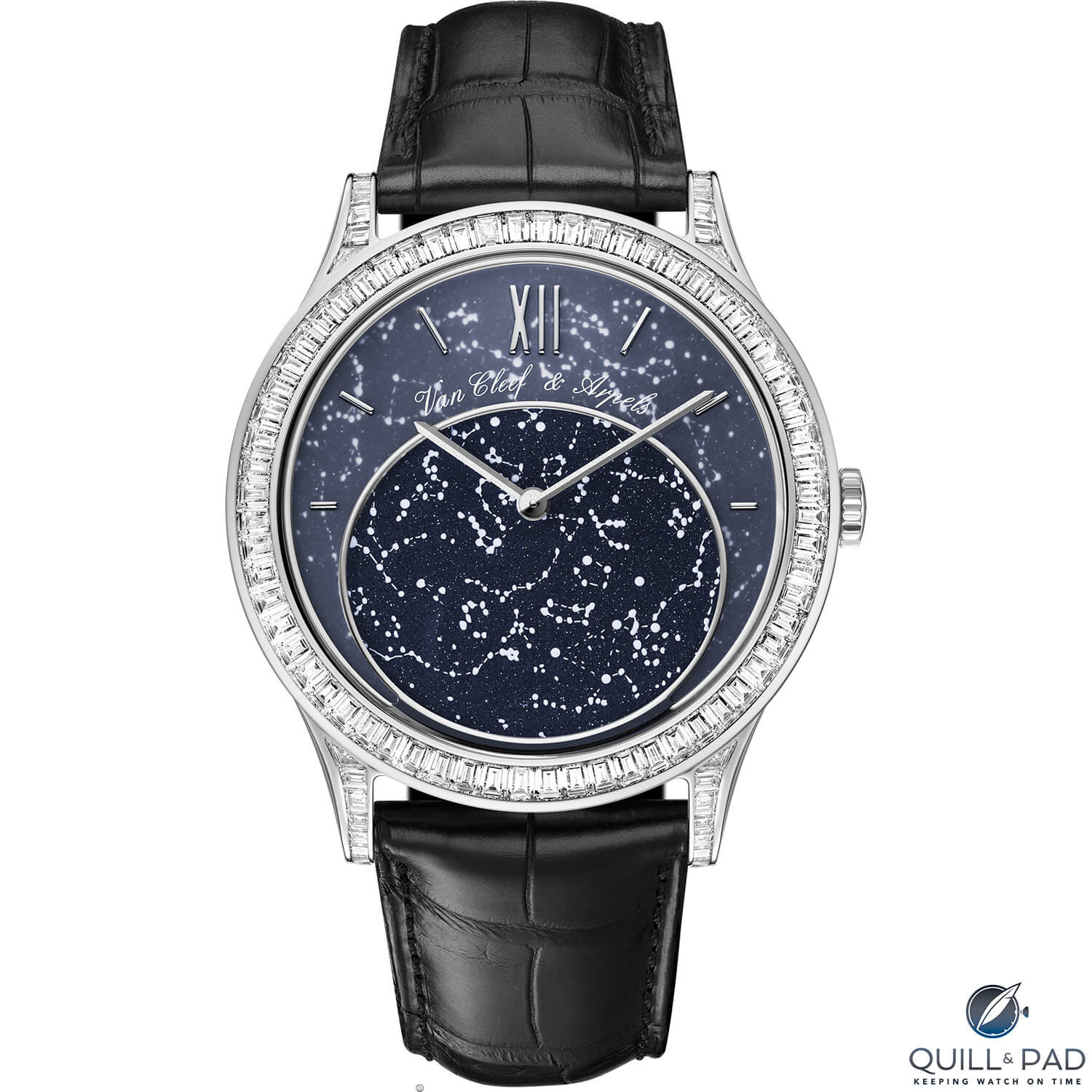
Van Cleef & Arpels Midnight in Paris from 2008 constituted the brand’s first use of aventurine
This is of course not the first time Van Cleef & Arpels has used the material – that began in 2008 with Midnight in Paris from the Poetic Complications line, which had been established shortly before that.
Quick Facts Van Cleef & Arpels Midnight in Paris
Case: 41 mm, 18-karat white gold
Movement: manually wound Jaeger-LeCoultre Caliber 849 with Agenhor four seasons module, 30-hour power reserve
Dial: aventurine underneath sky chart partially covered with smoky sapphire crystal
Functions: hours, minutes; star chart of Paris sky
Price: approx. $80,000
Frequent users on rare watches: Svend Andersen and Bovet
Independent watchmaker Svend Andersen has used aventurine for dials on a variety of his timepieces in unique executions. Some of these include the “tactful” Montre à Tact and a minute repeater with moon phase, both of which make sense because of the large expanse of otherwise unoccupied space on their dials.
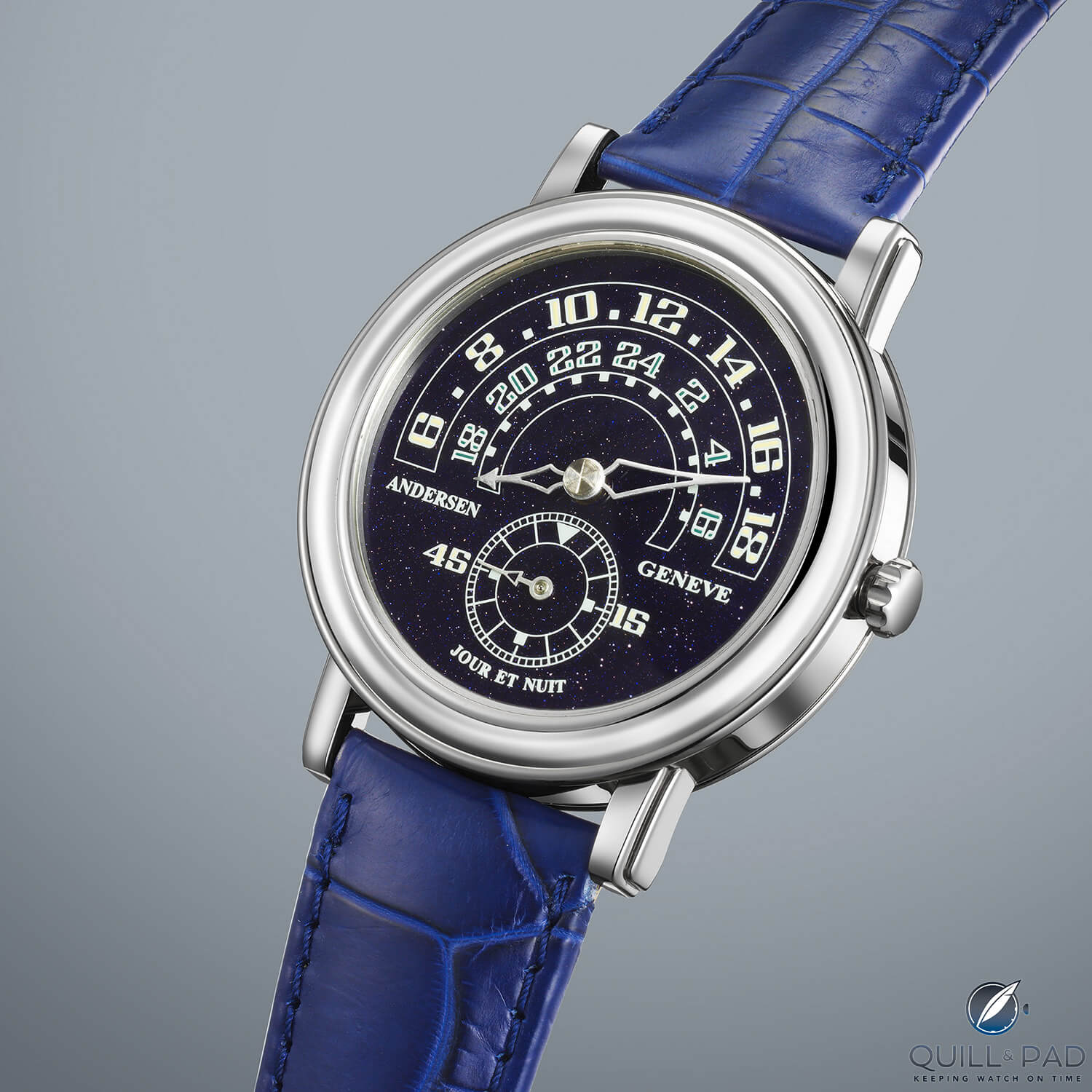
Andersen Genève’s Grand Jour & Nuit model with aventurine dial
One interesting use of aventurine I hadn’t seen before is 2006’s Grand Jour & Nuit, a highly unusual jump hour timepiece with separate arcs for the day and night hours. The minutes are shown in a separate subdial at the bottom. Andersen chose aventurine because of its ever-changing sparkle depending on how the light hits it.
Quick Facts Andersen Genève Grand Jour & Nuit
Case: 44 mm, 18-karat white gold
Movement: manually wound historical Frédéric Piguet base caliber
Dial: aventurine
Functions: jumping hours divided into day and night hours, minutes
Limitation: 20 pieces
Price: 54,000 Swiss francs (excluding VAT)
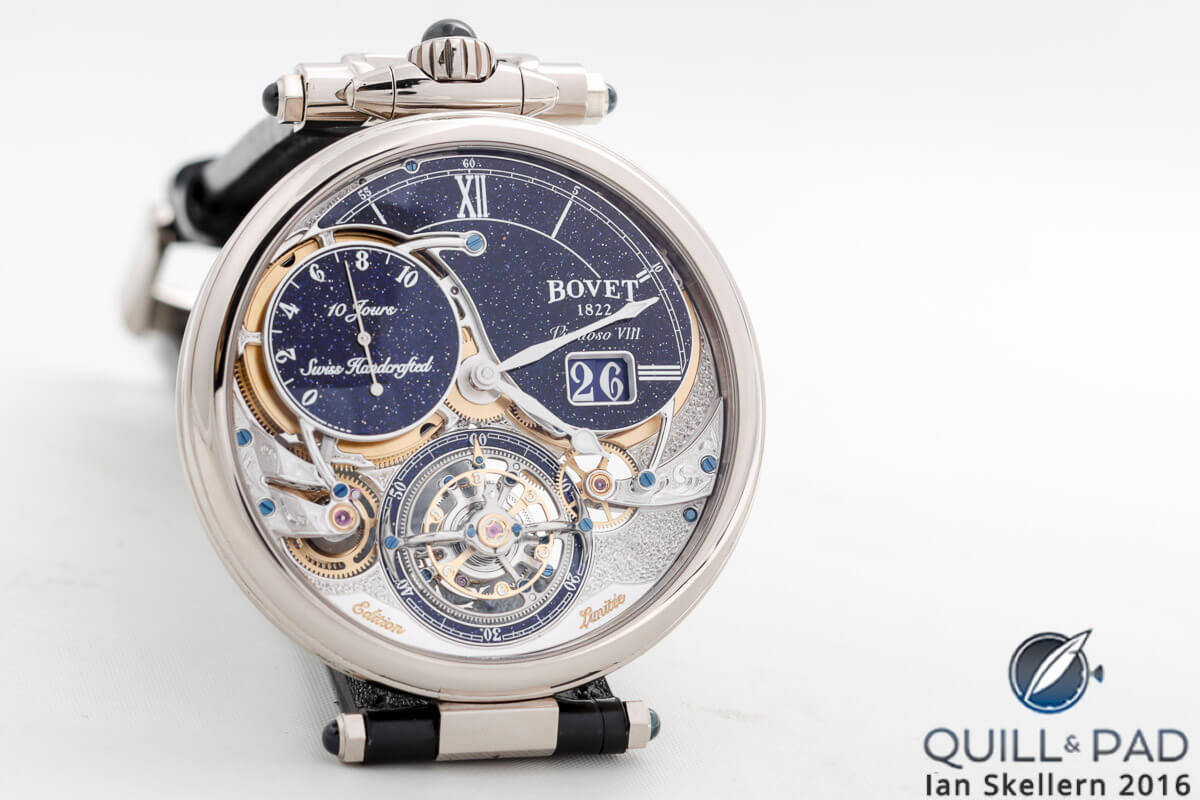
Bovet used aventurine elements to emphasize the beauty of its Virtuoso VIII from 2017
Bovet has been using aventurine on its watch dials since 2008, but 2017 was definitely a highlight year as far using this material was concerned.
This was the year the incredibly beautiful Virtuoso VIII arrived to help celebrate Bovet’s 195th anniversary. Positioned within the Fleurier Grandes Complications collection, this timepiece illustrates how the brand elevates artisanal watchmaking to new heights.
The Virtuoso VIII is also Bovet’s first timepiece in this collection to feature an inclined sapphire crystal, ensuring that the focal point remains on the flying tourbillon nestled among the intricate engraving and aventurine dial segments.
Other notable Bovet watches that feature aventurine include the Récital 11 Miss Alexandra and the Amadeo Fleurier Rising Star.
Quick Facts Bovet Virtuoso VIII
Case: 44 x 13.45 mm, 18-karat white or red gold
Movement: manually wound Bovet Caliber Virtuoso VIII with one-minute flying tourbillon, ten-day power reserve using one spring barrel and spherical differential; 2:5 Hz/18,000 vph frequency
Dial: aventurine
Functions: hours, minutes, seconds; large date
Limitation: 39 pieces in red gold, 39 pieces in white gold; fully customizable
Price: $209,800 (white gold), $199,800 (pink gold)
More aventurine at SIHH 2018: Parmigiani, Girard-Perregaux, A. Lange & Söhne
Parmigiani Fleurier began using aventurine on some of its watches in 2016, and the brand has wasted no time building a large collection with it – which points toward success with the design.
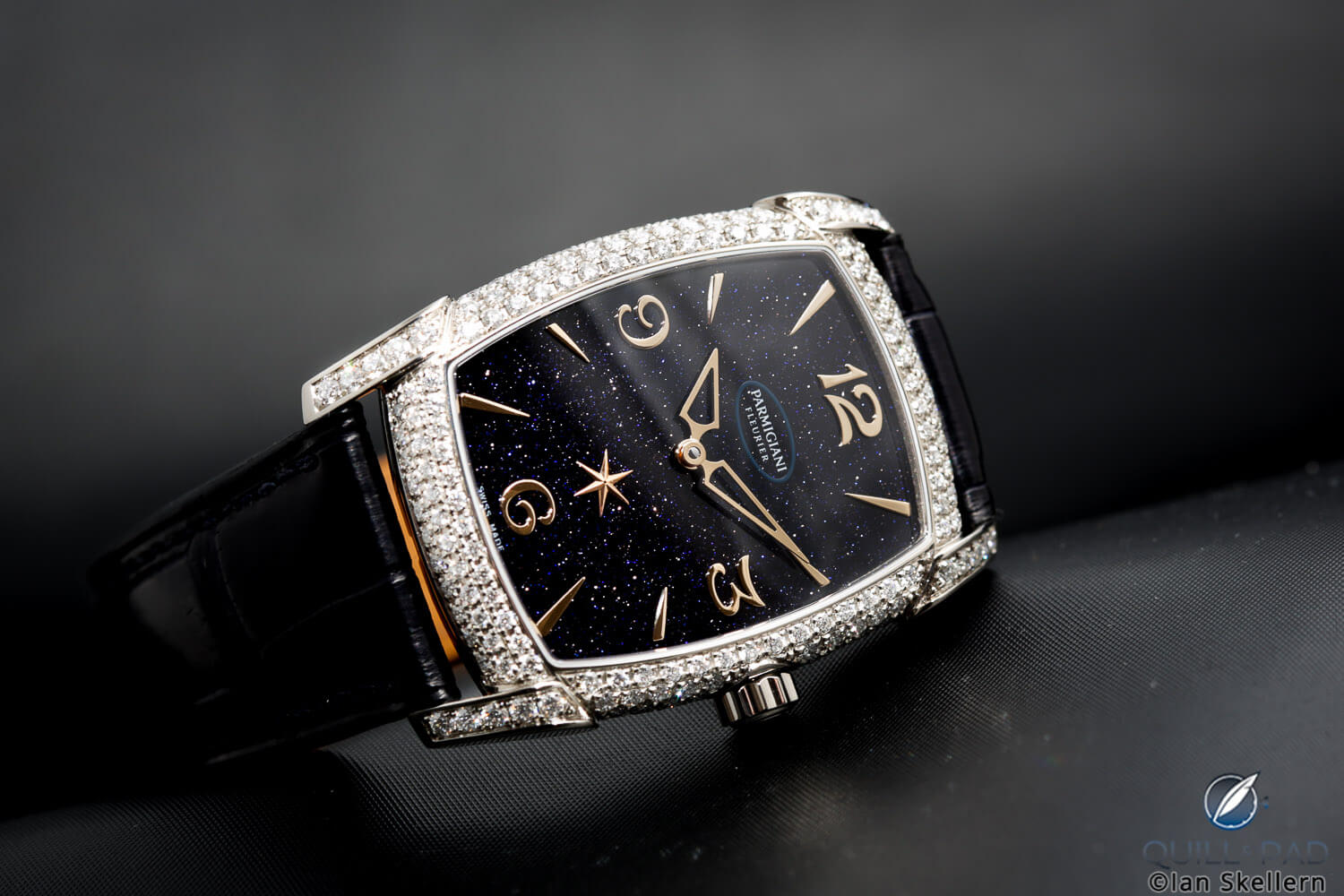
Parmigiani Kalparisma Nova Galaxy from SIHH 2018
“Generally speaking, Parmigiani has been using the color blue for its dials for some time now. It is an elegant, discreet, subtle, and timeless color that is today for many brands, as for us, a bestseller in both men’s and women’s watches,” Flavien Gigandet, member of the brand’s executive committee, confirms.
“The aventurine glass, also called goldstone, is challenging to produce, and we love challenges. The material and its color are full of charm and history and blend very well with the rose or white gold color of watch cases.”
Today in the collection we find three rectangular Kalparisma Nova Galaxy models and five round Tonda models – including the complicated Tonda 1950 Tourbillon Galaxy – outfitted with the beautiful, shimmering glass material. See more on some of the brand’s new aventurine-outfitted watches from SIHH 2018 in Parmigiani Fleurier’s Kalparisma Nova Galaxy Featuring An Exquisite Aventurine Dial Is A Celestial Delight.
Quick Facts Parmigiani Fleurier Kalparisma Nova Galaxy
Case: 37.5 x 31.2 x 8.4 mm, white gold with 182 brilliant-cut diamonds (2.28 ct) or pink gold with 46 brilliant-cut diamonds (0.84 ct)
Dial: aventurine
Movement: automatic manufacture Caliber PF332, 4Hz/28,000 vph frequency, power reserve 55 hours
Functions: hours, minutes, subsidiary seconds
Limitation: 8 pieces (white gold), 50 pieces (pink gold)
Price: $34,900 (white gold), $24,900 (pink gold)
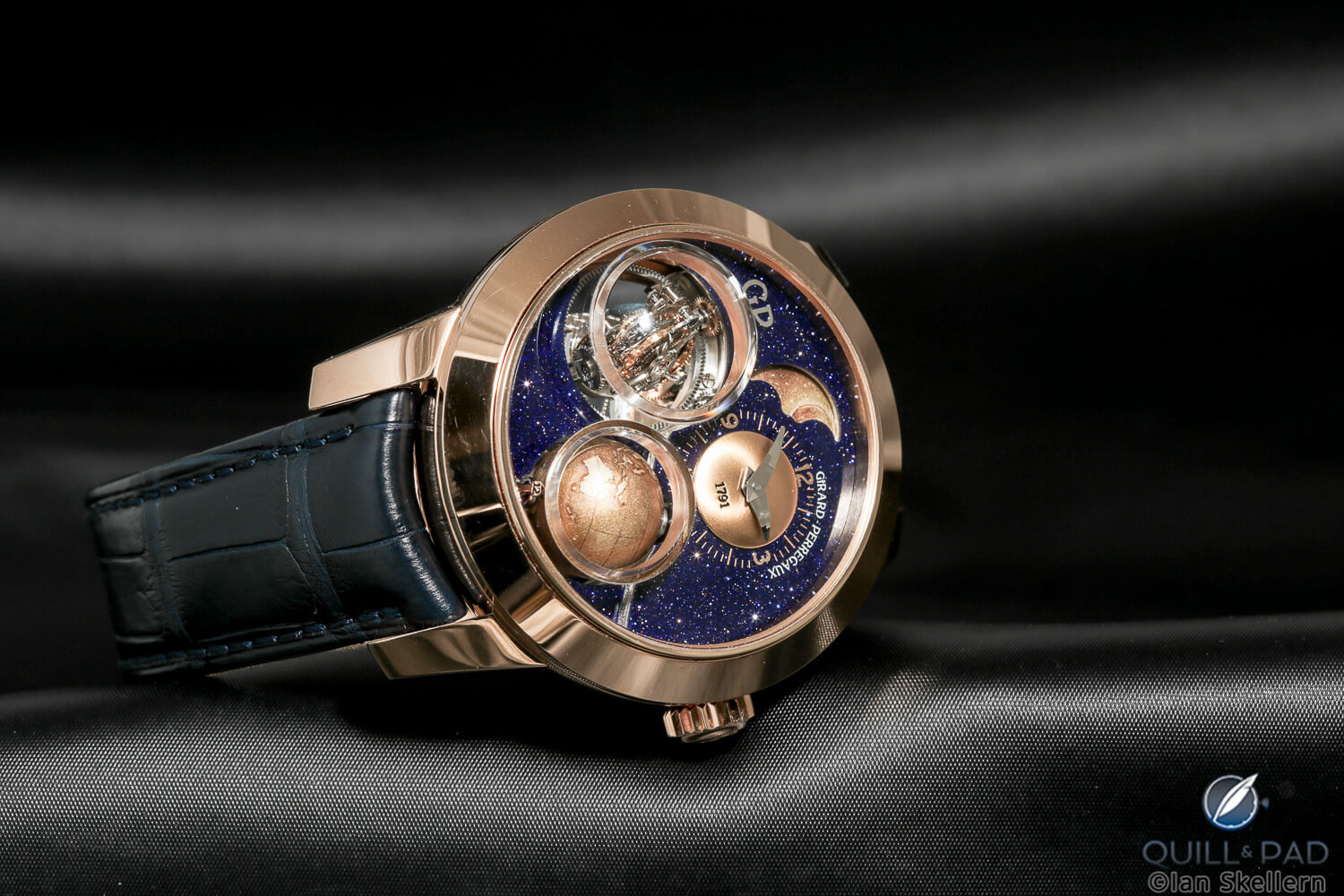
Girard-Perregaux introduced an aventurine-outfitted edition of its complicated Planetarium Tri-Axial at SIHH 2018
Girard-Perregaux came out with a handful of aventurine-outfitted watches at the 2018 SIHH across two model families. But the Planetarium Tri-Axial Tourbillon is probably the most interesting of them in that it combines a very high complication with the sparkling glass. Unusually combined with a pink gold case not set with diamonds, I personally like it a bit less as the soft color of this gold doesn’t allow the glass material to sparkle as much as it normally would. But please tell me in the comments how you like the combination!
Quick Facts Girard-Perregaux Planetarium Tri-Axial Tourbillon
Case: 48 x 18.66 mm, pink gold
Dial: aventurine with pink gold accents
Movement: manually winding Caliber GP09310-0001 with tri-axial tourbillon; 60-hour power reserve; 21,600 vph / 3 Hz frequency
Functions: hours, minutes; moon phase, second time zone with day/night indication (global time)
Price: $321,000
Though it is not first time aventurine was used in the Girard-Perregaux Cat’s Eye line, the new 2018 collection from SIHH called Day and Night illustrates perhaps the most breathtaking use of the material.
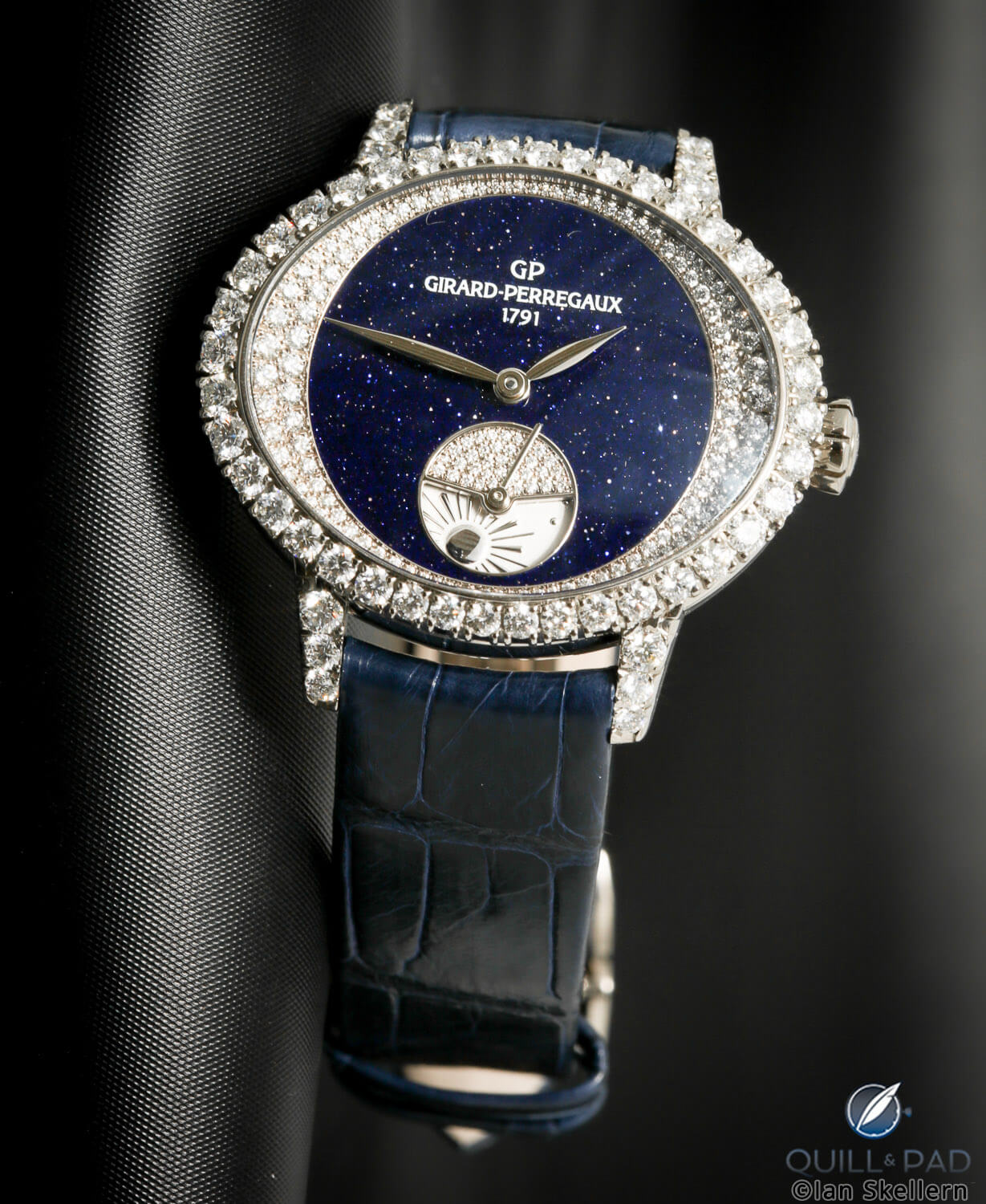
Diamond-set Girard-Perregaux Cat’s Eye Day and Night with aventurine dial
By combining it with intricate diamond settings of different sizes that really play to the oval shape of this special watch sets off the beautiful aventurine dial in a spectacular way.
Quick Facts Girard-Perregaux Cat’s Eye Day and Night
Case: 36.9 x 30.75 x 11.3 mm, white gold with 52 brilliant-cut diamonds (2.31 ct)
Dial: aventurine and with diamonds on sides and moon window (149 brilliant-cut diamonds, ~0.52 ct.)
Movement: automatic manufacture Caliber GP03300-0090, 4Hz/28,000 vph frequency, power reserve 46 hours
Functions: hours, minutes, seconds; day/night indicator
Price: $52,500
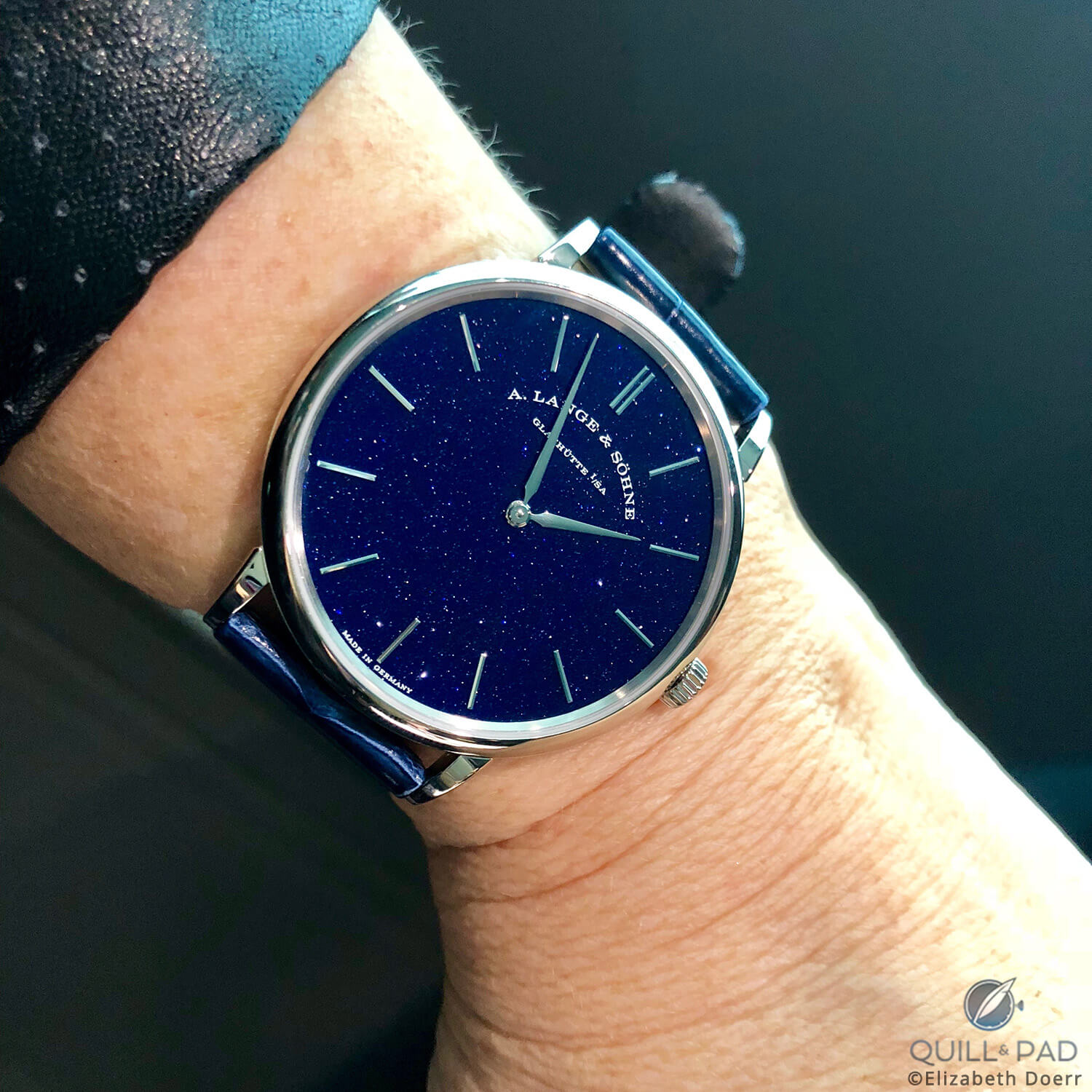
A. Lange & Söhne introduced a very surprising model at SIHH 2018: the Saxonia Thin with aventurine dial
A. Lange & Söhne introduced a very surprising model at SIHH 2018: the Saxonia Thin with aventurine dial. It was so surprising because in its entire history, this brand has never used aventurine or any material even remotely like it. But using it on the Saxonia Thin was a stroke of genius: it became a watch to instantly fall in love with. See more on the Saxonia family’s history and development in Second-Row Stars: A. Lange & Söhne’s Saxonia Model Family.
Quick Facts A. Lange & Söhne Saxonia Thin 2018
Case: 39 x 6.2 mm, white gold
Dial: solid silver covered by a thin layer of aventurine
Movement: manual winding manufacture Caliber L093.1 with manual winding, 3 Hz/21,600 vph frequency, power reserve 72 hours
Functions: hours, minutes
Price: €20,800
Occasional use makes for eye-popping beauty
La Montre Hermès is known for occasionally doing something unusual and playful with its watches. The Arceau Pocket Iles et Ecailles with its scarab beetle marquetry is one such example.
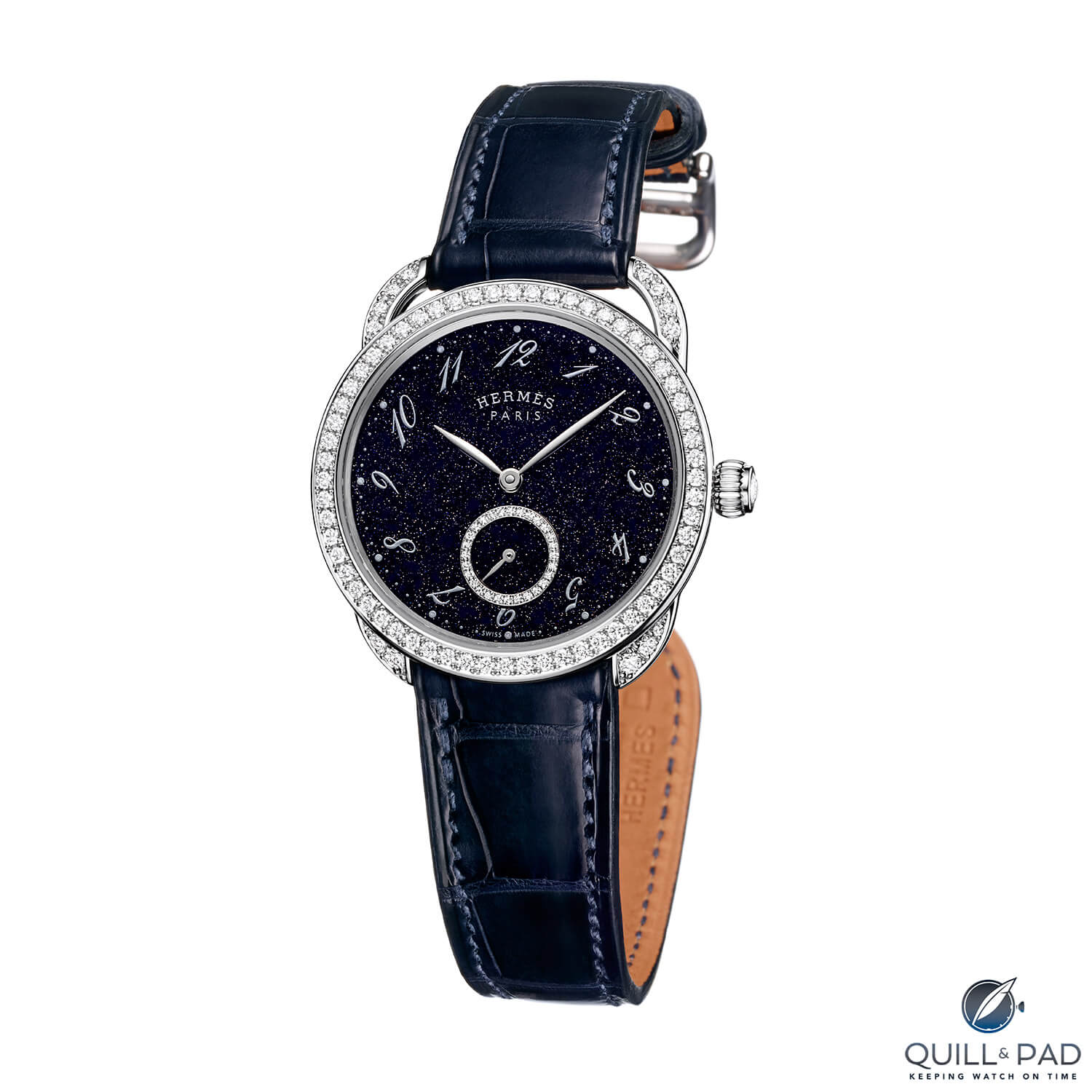
Hermès Arceau Ecuyere Aventurine from 2015
And the Arceau Ecuyère Aventurine from 2015 is another excellent example. According to director of design at La Montre Hermès, Philippe Delhotal, “The aventurine together with the diamonds are a perfect match.”
Delhotal also said that the objective of using aventurine was to have more reflection and brilliance on the dial and to give the watch a more precious touch.
Quick Facts Hermès Arceau Ecuyère Aventurine
Case: 34 mm, white gold set with 74 diamonds (0.94 ct)
Dial: aventurine set with 28 diamonds
Movement: automatic manufacture Caliber H1912, 50-hour power reserve
Functions: hours, minutes, seconds
Limitation: 178 watches
Price: $49,500 / €36,900 / 41,900 Swiss francs
In that same year, Montblanc introduced a beautiful pocket watch with aventurine on the dial: the 4810 Villeret Tourbillon Cylindrique Pocket Watch 110 Years Edition, which you can read much more about in Montblanc Celebrates 110 Years With 2 Pocket Watches And Special Edition Wristwatches From The 4810 Collection.
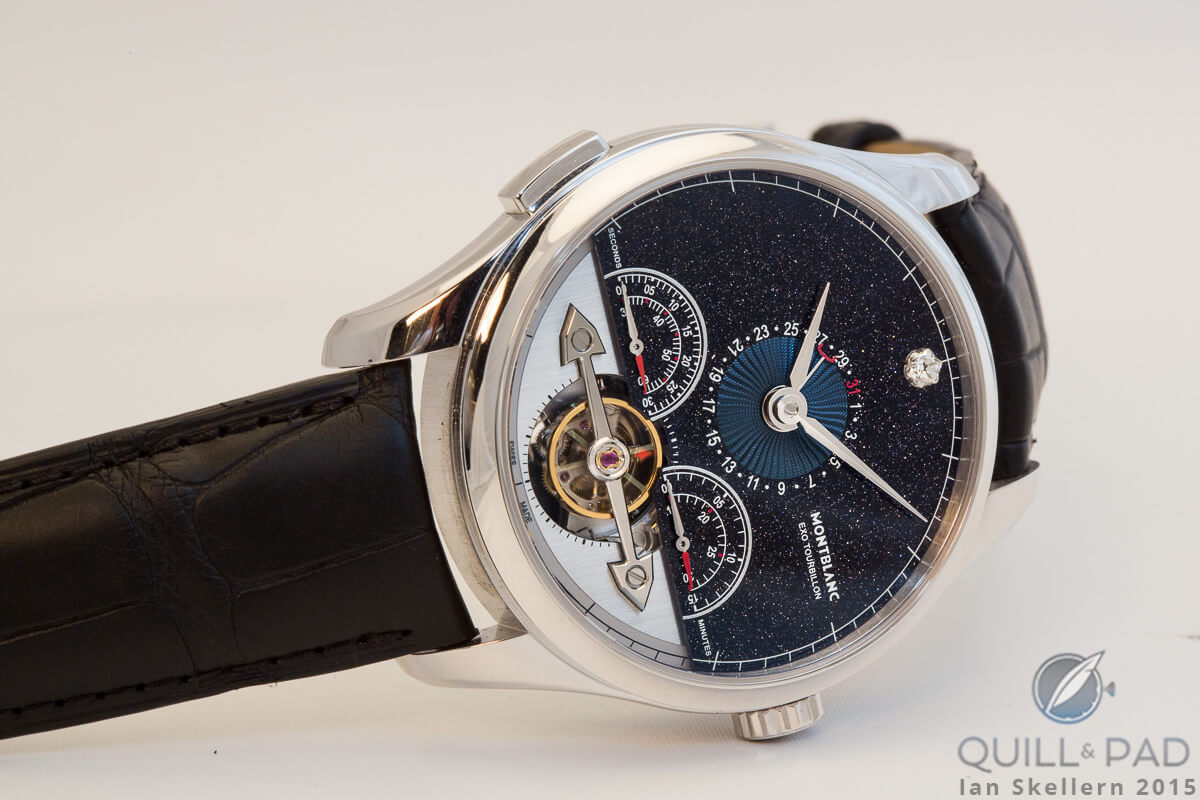
Montblanc Heritage Chronométrie ExoTourbillon Minute Chronograph with aventurine dial segment
And just before that, the Heritage Chronometrie Exotourbillon Chronograph Vasco da Gama came out, also decorated with aventurine on the dial to symbolize the starry night sky that explorer Vasco da Gama used as a map to navigate and explore. See more about this unusually beautiful and complicated watch in BOOM! Montblanc’s Explorer-Inspired Heritage Chronométrie Collection.
Quick Facts Montblanc Heritage Chronometrie Exotourbillon Chronograph Vasco da Gama 60
Case: 44 x 14.79 mm, white gold
Dial: aventurine with Montblanc-cut diamond at 12 o’clock
Movement: automatic Caliber MB R230 (Sellita SW300 base) with one-minute tourbillon
Functions: hours, minutes, seconds; date (backward and forward setting), chronograph
Limitation: 60 pieces
Price: €45,000
Aventurine is used sparingly throughout the collections of many watch brands, including Audemars Piguet, Bulgari, Chanel, Dior, Zenith, Ulysse Nardin, Piaget, and Boucheron. But keep an eye out for it as I’m sure this lovely glass will continue to surprise and delight watch connoisseurs for a long time to come.
Sources
Edelsteine und Schmucksteine, Walter Schumann, BLV Verlagsgesellschaft
Encyclopedia Britannica
www.mindat.org/min-436.html
https://en.wikipedia.org/wiki/Goldstone_(glass)
Murano, its Glass, and its People, edited by Stanley B. Kruger
Trackbacks & Pingbacks
-
[…] Some more information about the aventurine dial and some examples can be found in this great article by Elizabeth Doerr for Quill&Pad: Aventurine: Sparkling, Glittering, Mysterious, And Placing A Galaxy Of Stars On Your Wrist. […]
-
[…] steel version has a dial cut from onyx. As our editor-in-chief, Elizabeth Doerr, explained in a recent article on aventurine, cutting dials from semiprecious stone is not for the faint-hearted. Yet I thought the dial design […]
Leave a Reply
Want to join the discussion?Feel free to contribute!





















































Fascinating article (which must have taken a lot of hard work to bring together).
Thanks for that!
Thanks for recognizing that, Ian! You know, when I started writing I realized there was so much to this topic and it was just fun to keep digging! Aventurine is one of my personal favorites in terms of special elements.
Thanks for compiling this article, it is a great read.
Aventurine is truly a fascinating material. Seems like it may be pretty rare to get a hold of one of these time pieces.
Thank you for the appreciation! They are pretty rare watches, but they’re out there.
Great article Elizabeth! The green aventurine on Louis Moinet dial is gorgeous.
Thank you so much, Yannick! I love that green aventurine dial too.
You forgot Schaumburg Watch Company’s line of Moon watches. They use blue goldstone. Their Moon watches has the largest size moon phase of any watch. They are made in Germany.
This listing is not exhaustive, so thank you for your comment.
Great article, I have been looking forward to finding something more on Aventurine watches for sometime now, I own your least favorite Omega Aventurine Speedmaster or ” Phantom Watch” from 2012. I fell in love with it on a Black Strap and when I look into my moonwatch I see Stars in Space, but all this time I was lead to believe it was Natural Aventurine from the Quartz family 🙁 now come to find out its just glass thats hard to work with …
Just because I don’t love the look of that particular watch doesn’t mean it isn’t great for someone else. I’m very glad you love it so much! Aventurine is a fantastic material!
I’m sorry the salesperson you spoke to wasn’t as informed as he or she should have been. There is a lot of confusion and myth surrounding aventurine: I originally wrote this article in great part as a response to a press presentation from someone I deeply respect (and who usually has all the facts straight!), in which there was a great degree of uncertainty as to what exactly the material was. The rule of thumb is: it is always glass unless explicitly stated that it is the natural stone. Normally as a consumer you can already see that in the color and texture.
Enjoy your Phantom Watch!
Great read! Trove of info! IMHO, aventurine dials are most impressive when unadorned with complications. You want to be able to see the “expanse of the starry universe” if you know what I mean. And yes, naturally, white diamonds on the case/bezel do enhance the look. Otherwise, like in Bovet and that GP complicated watches, the effect is lost because the glass is broken up. while I appreciate how difficult it is to make such broken-up dials out of this material, sometimes simple beauty trumps technological achievements. And I am pretty sure Yannik is a men’s name.
Thank you for reading and I’m glad you appreciated all the research that went into this piece. On another note, I happen to know Yannick Nardin personally and I can assure you she is very much a woman.